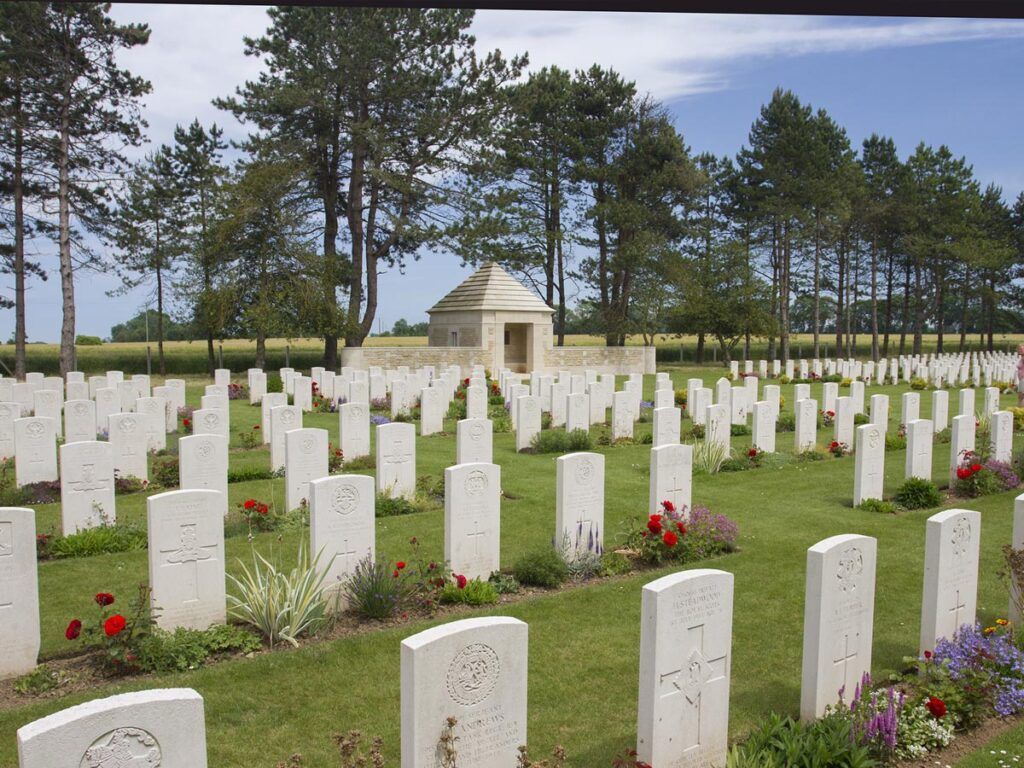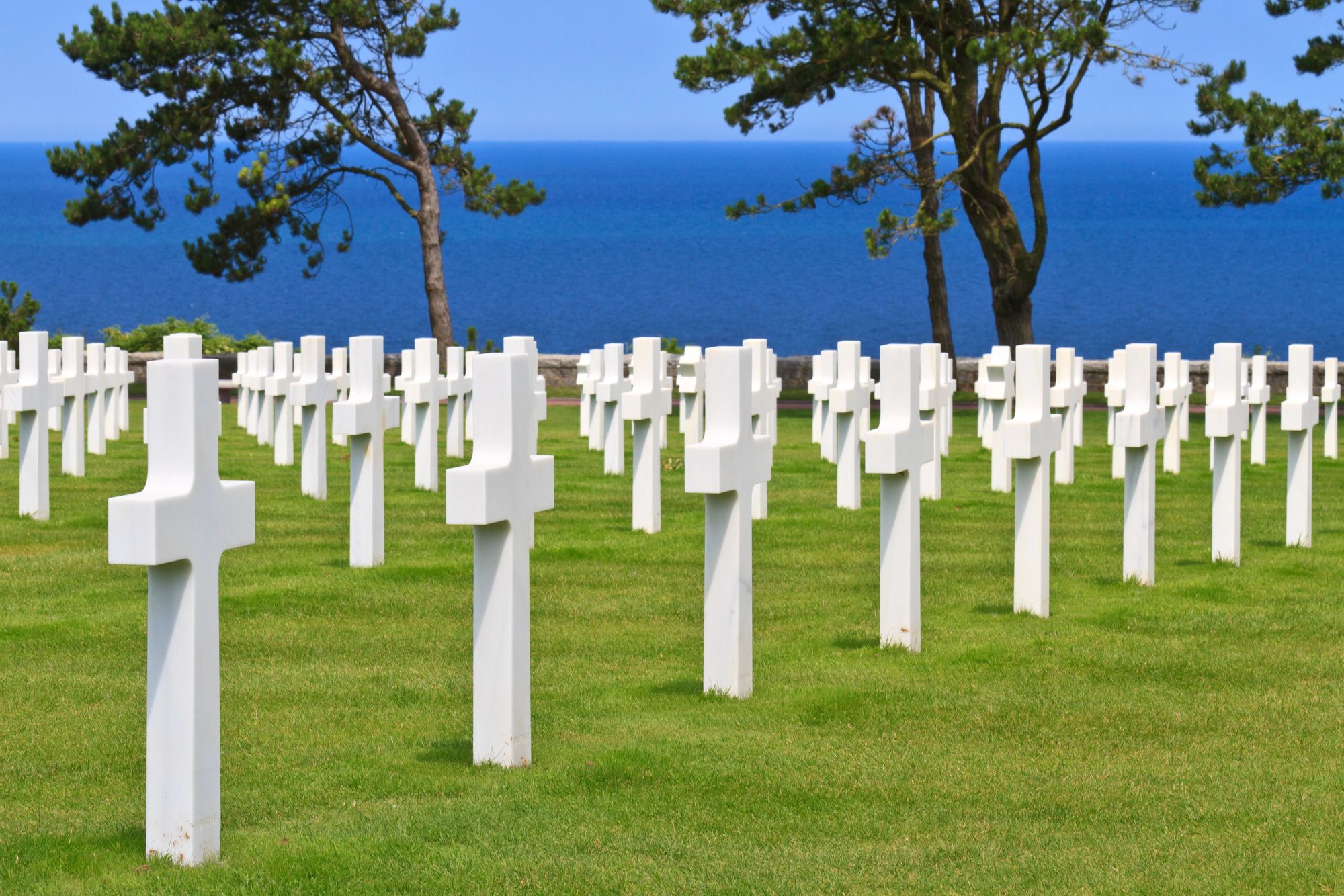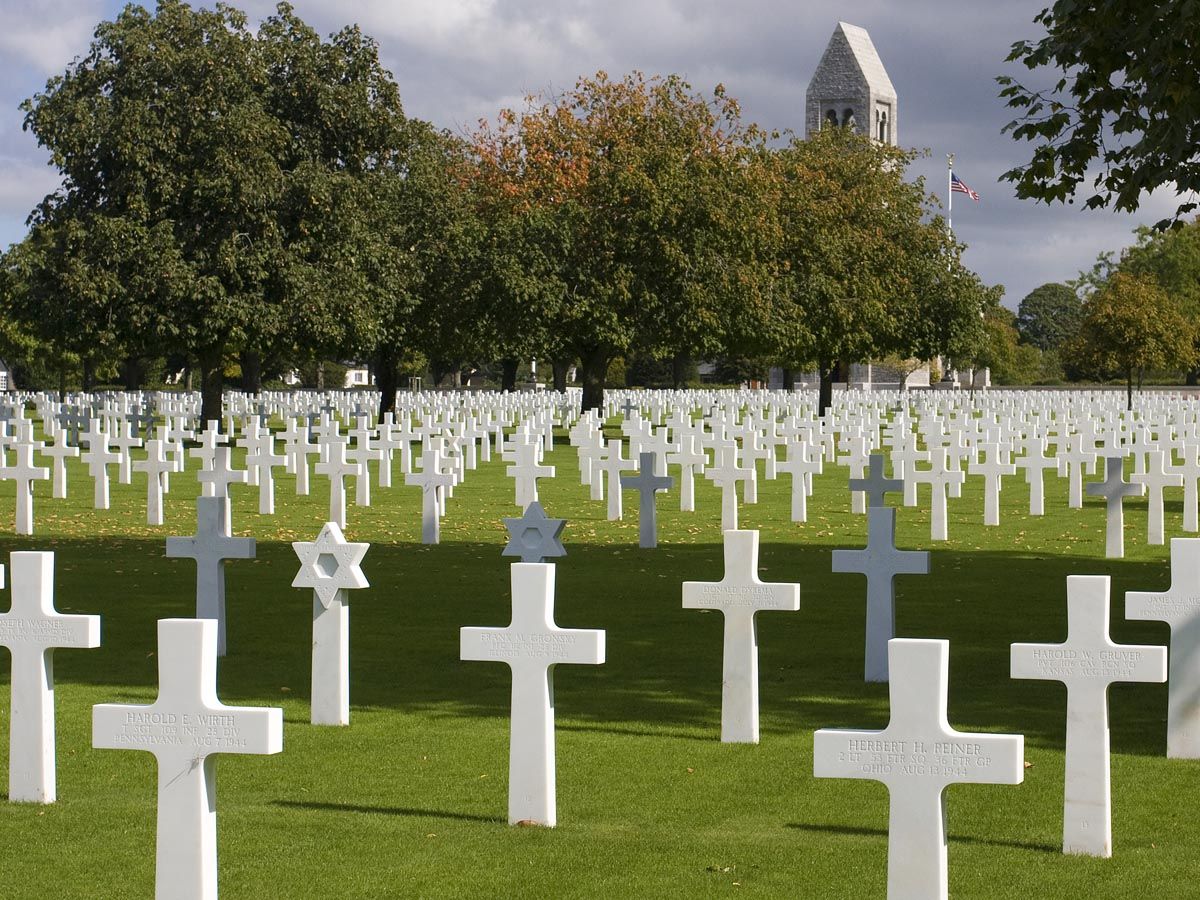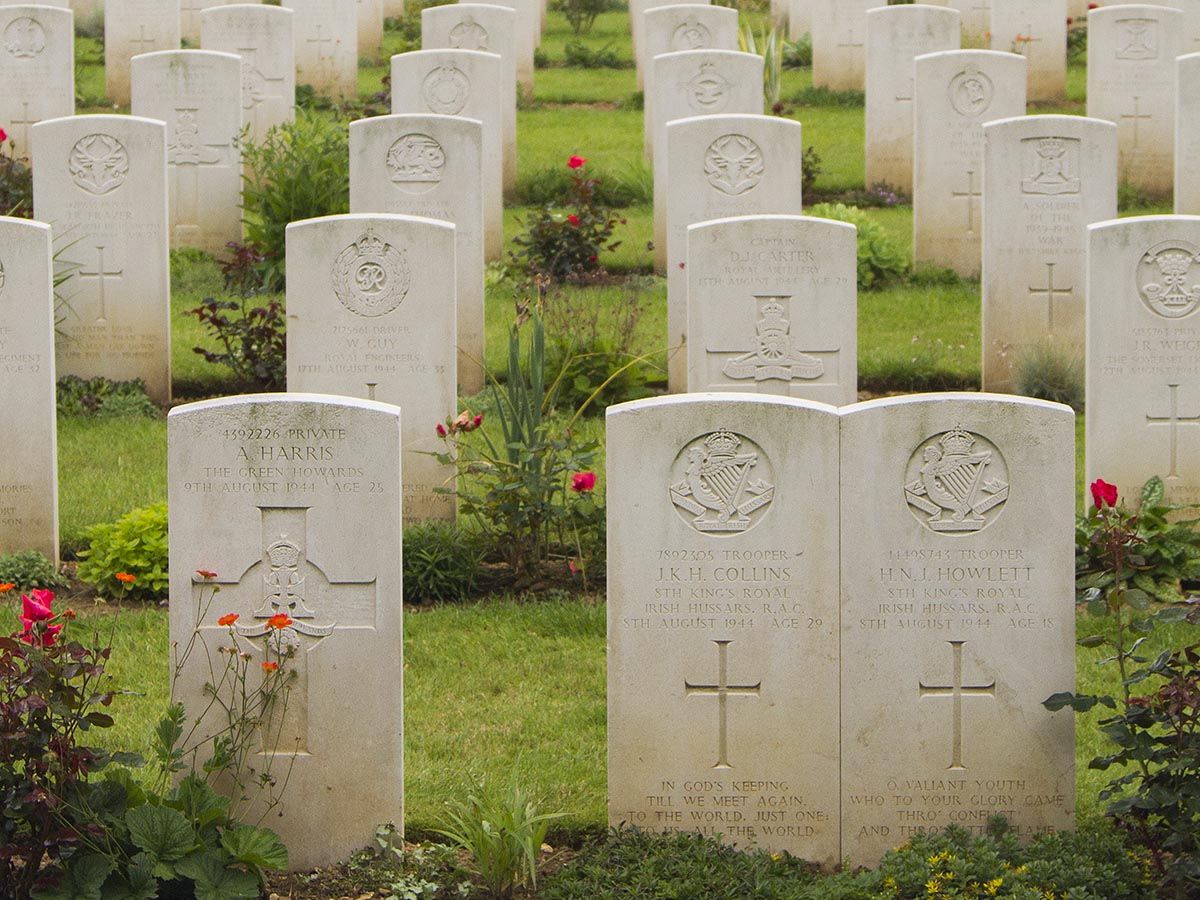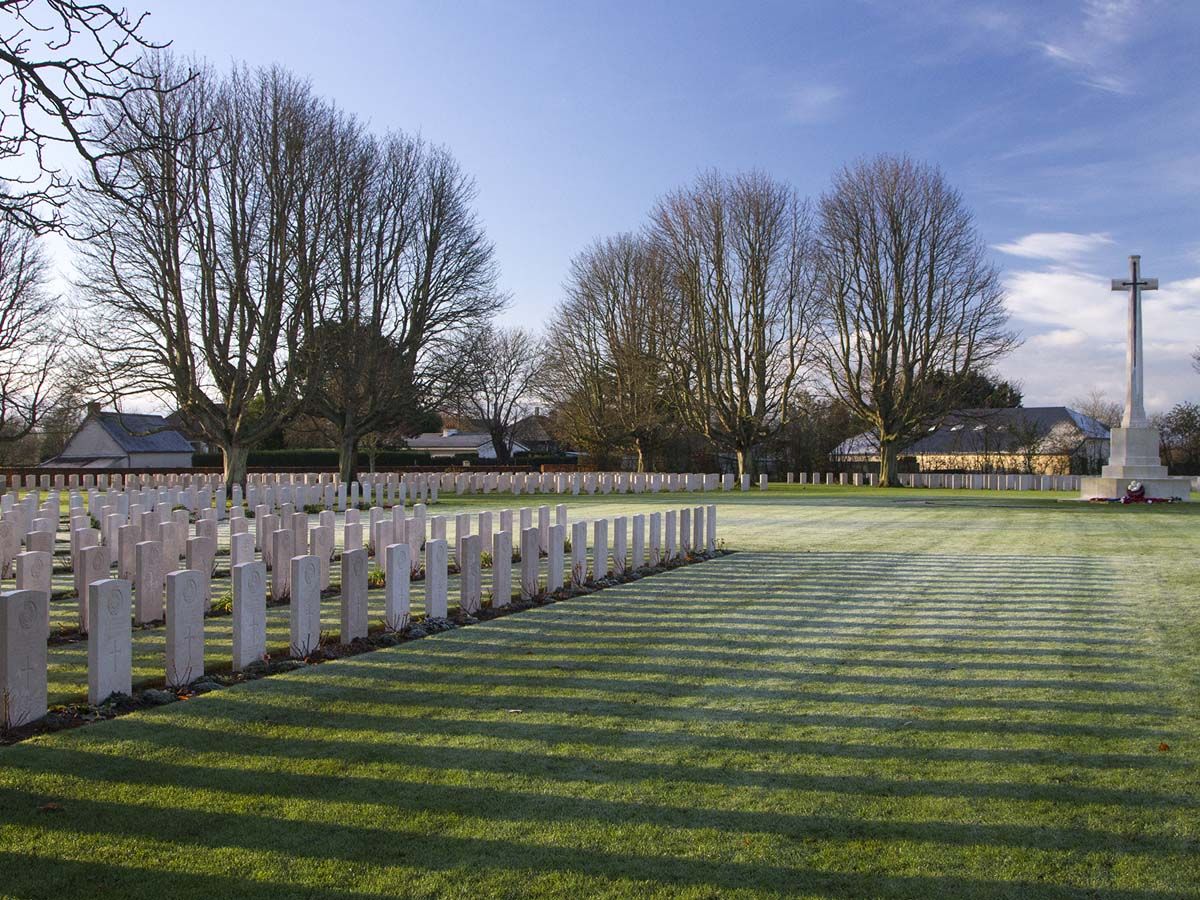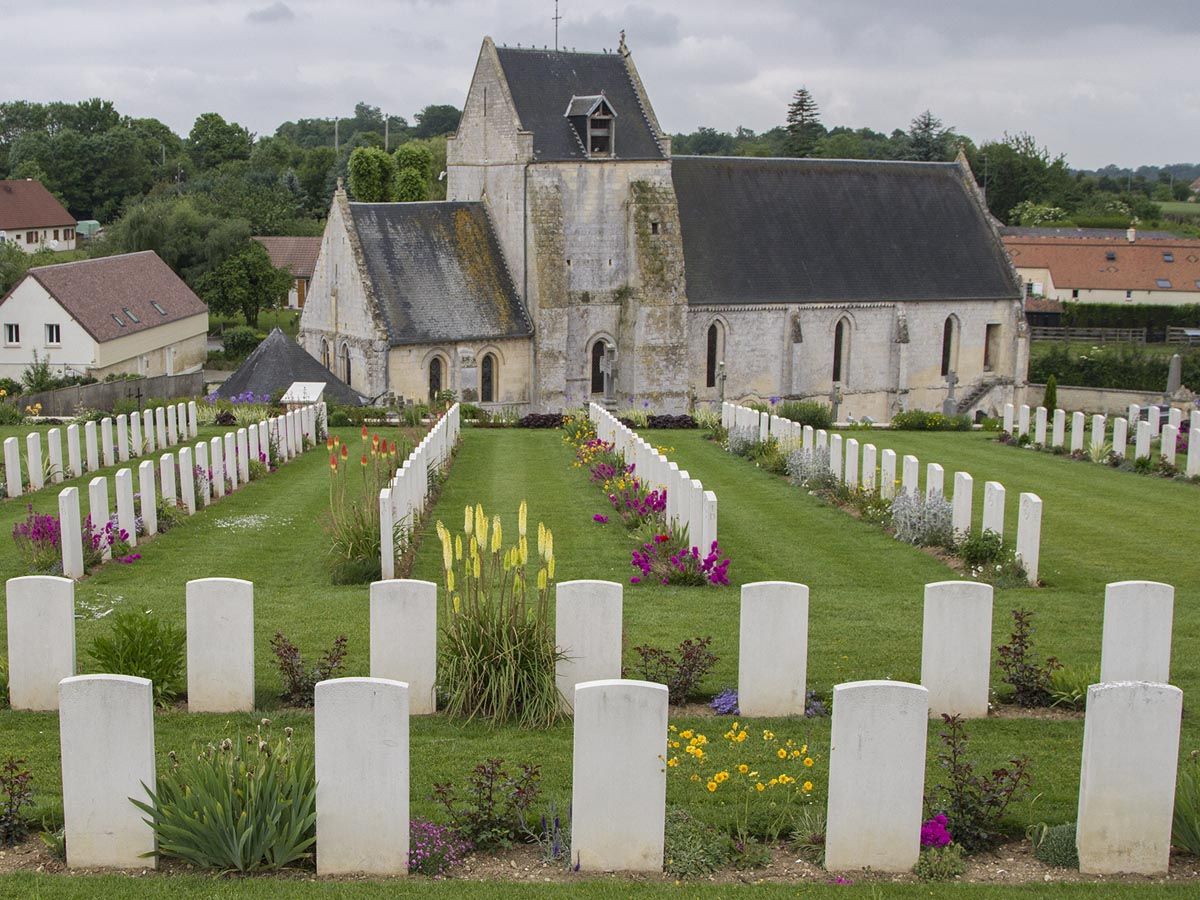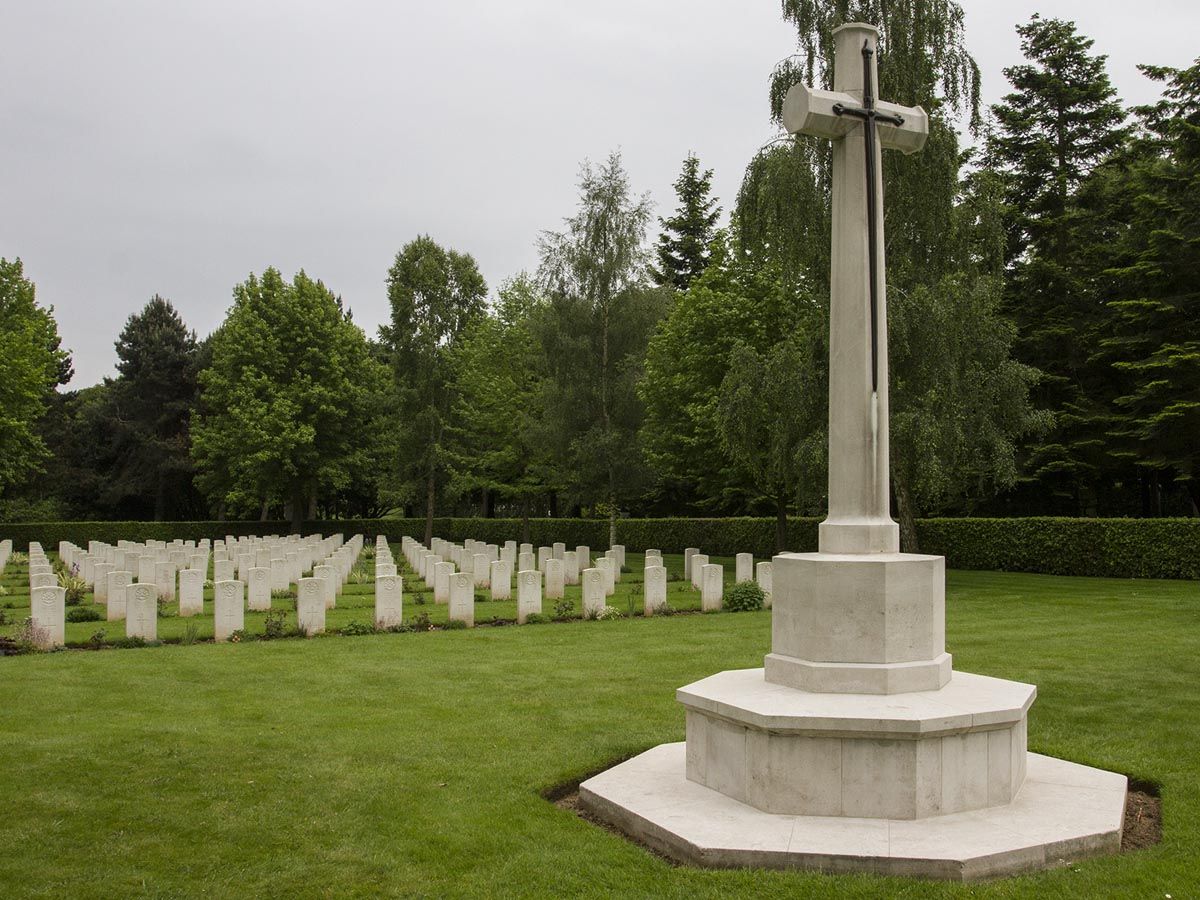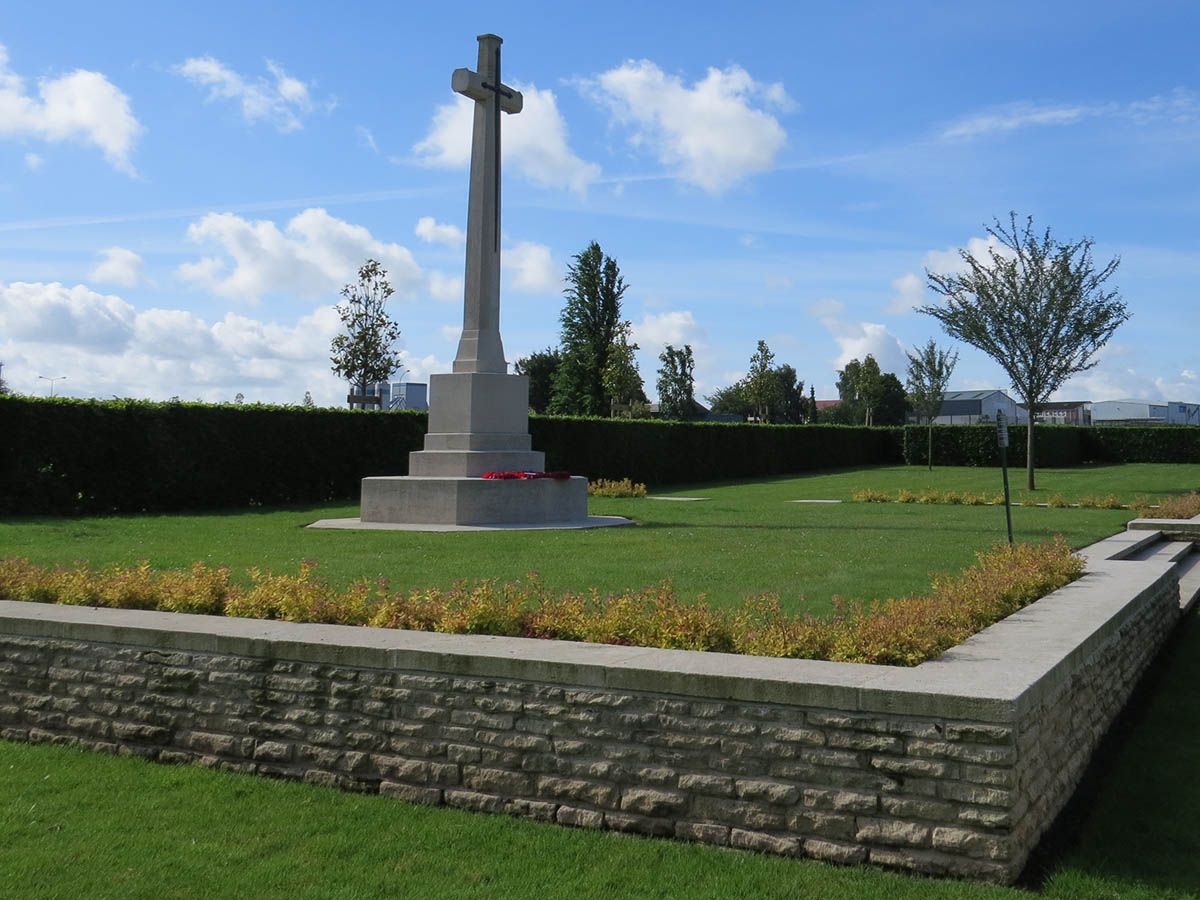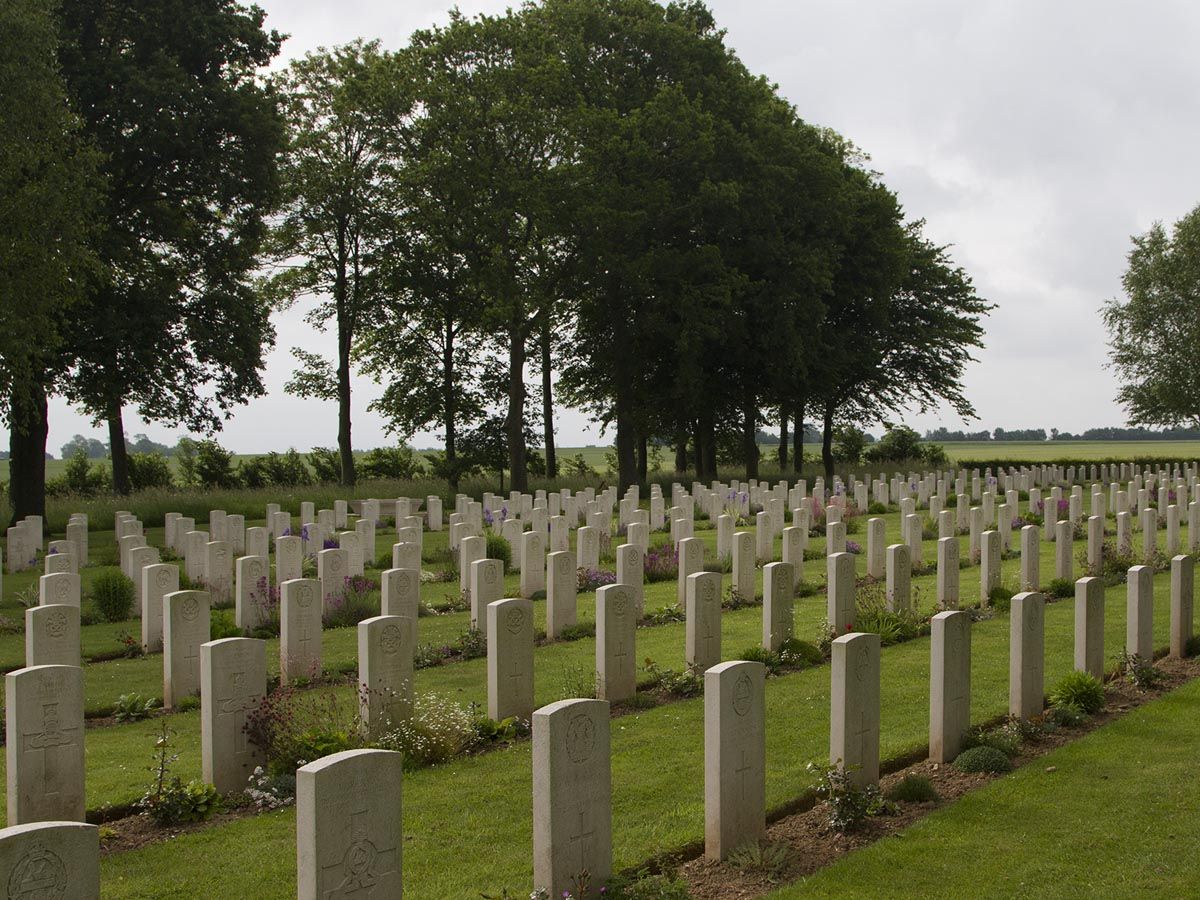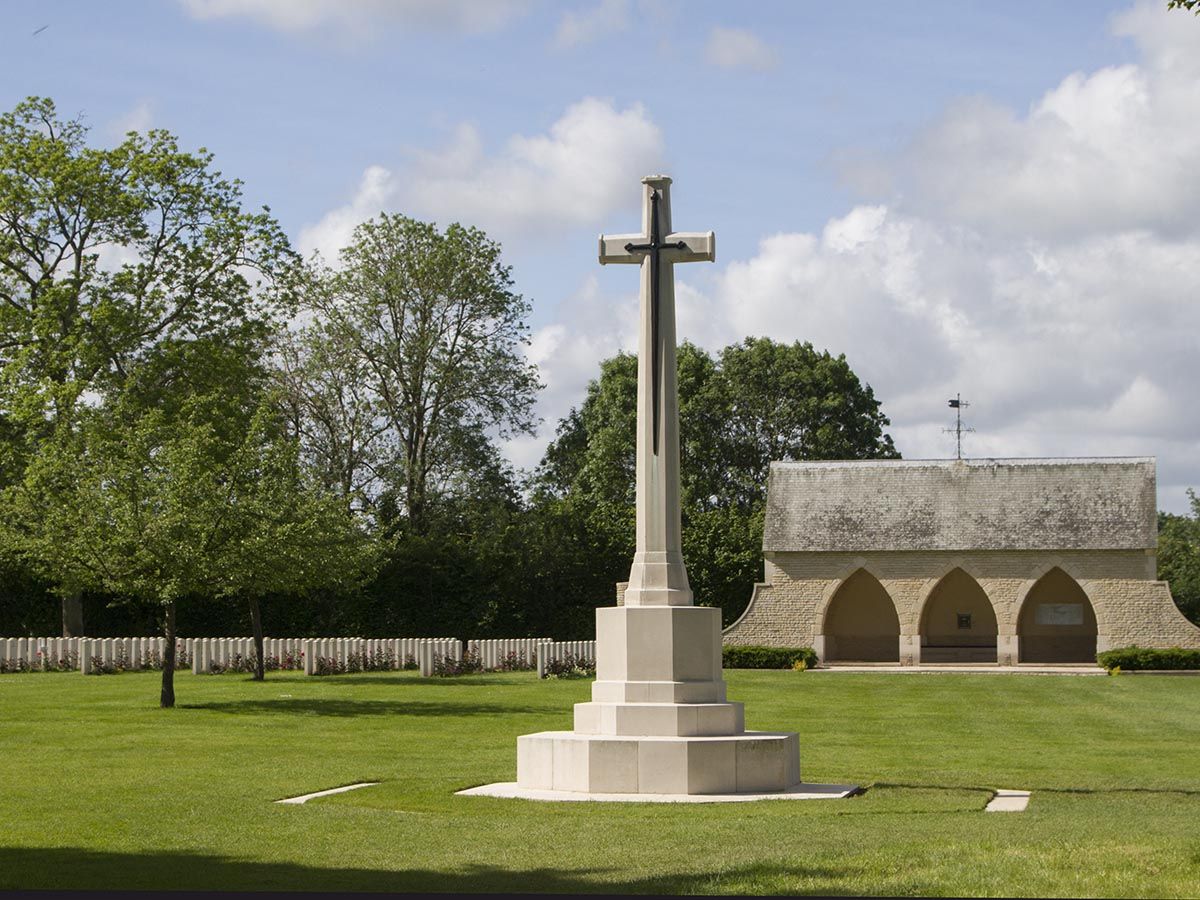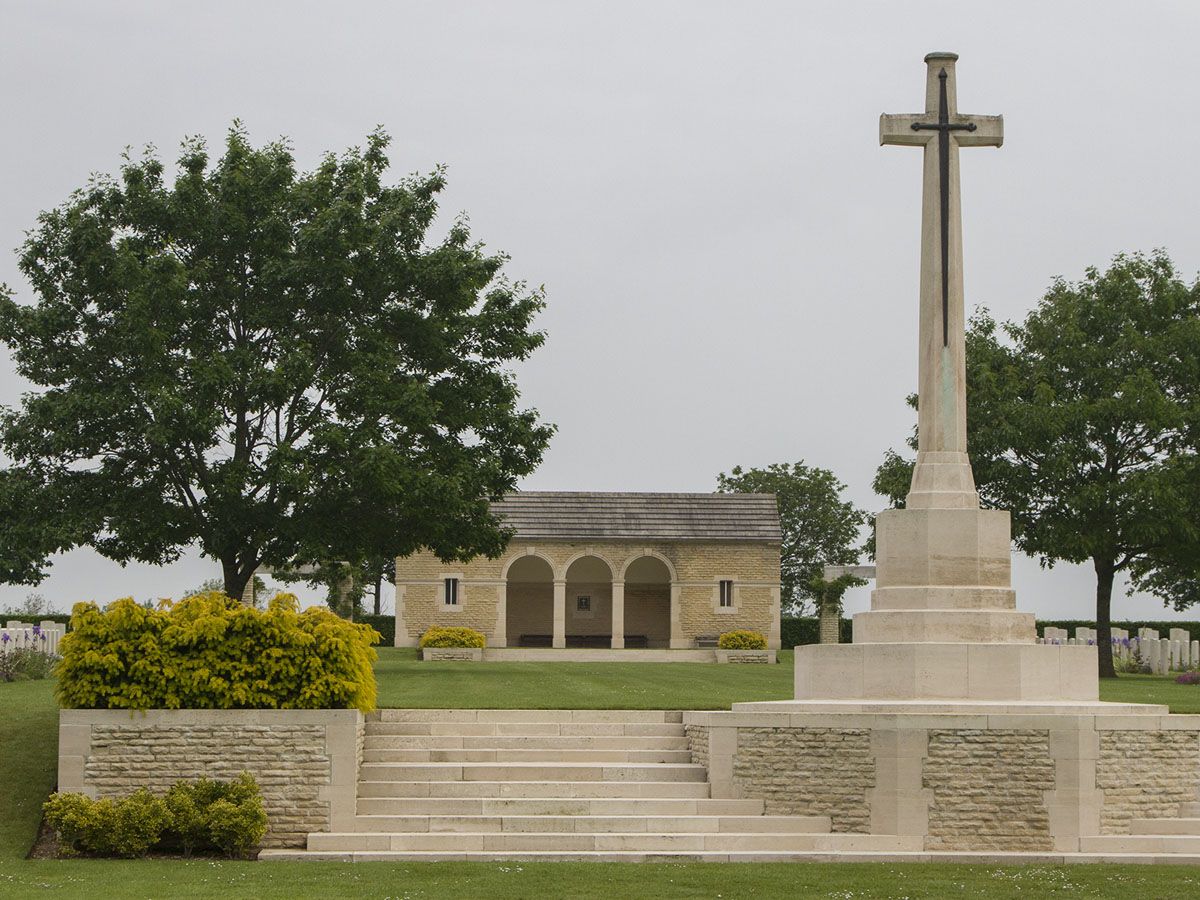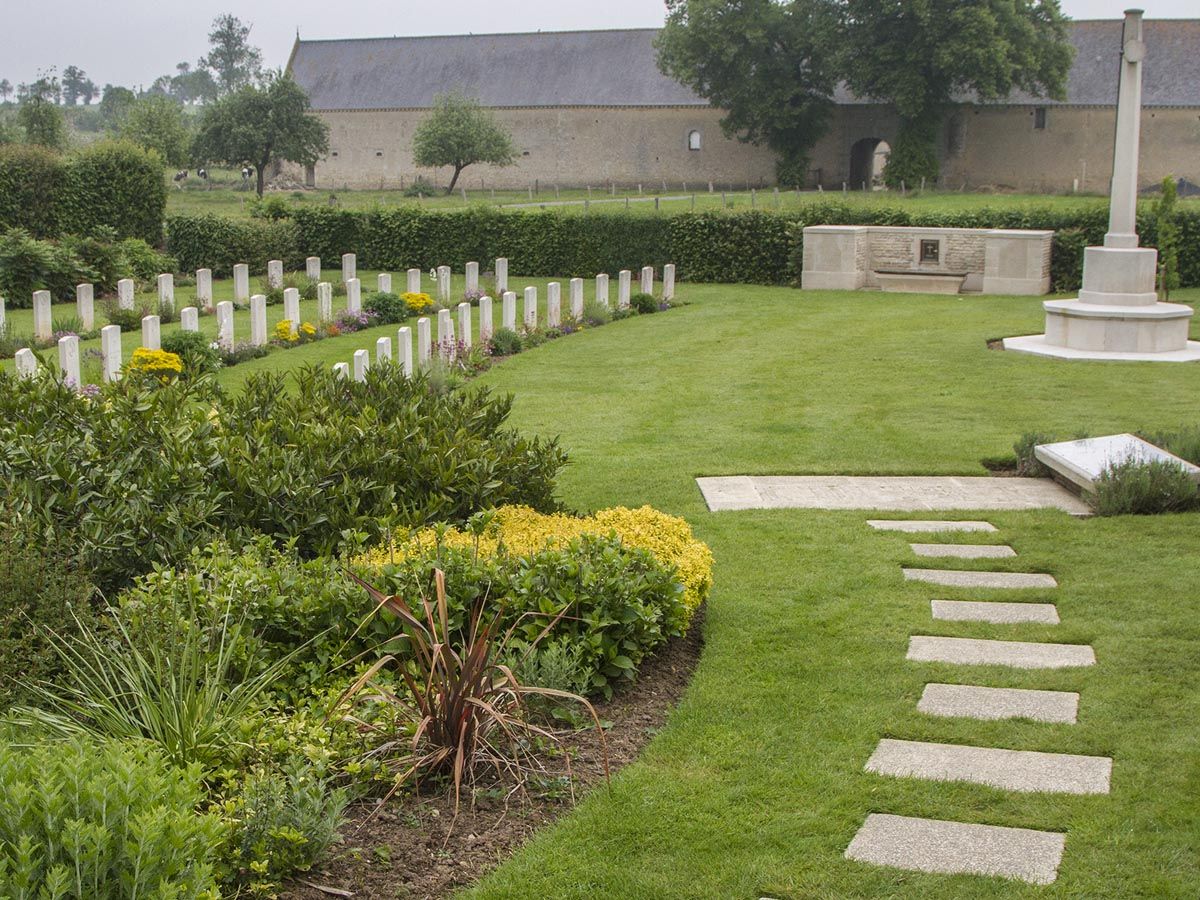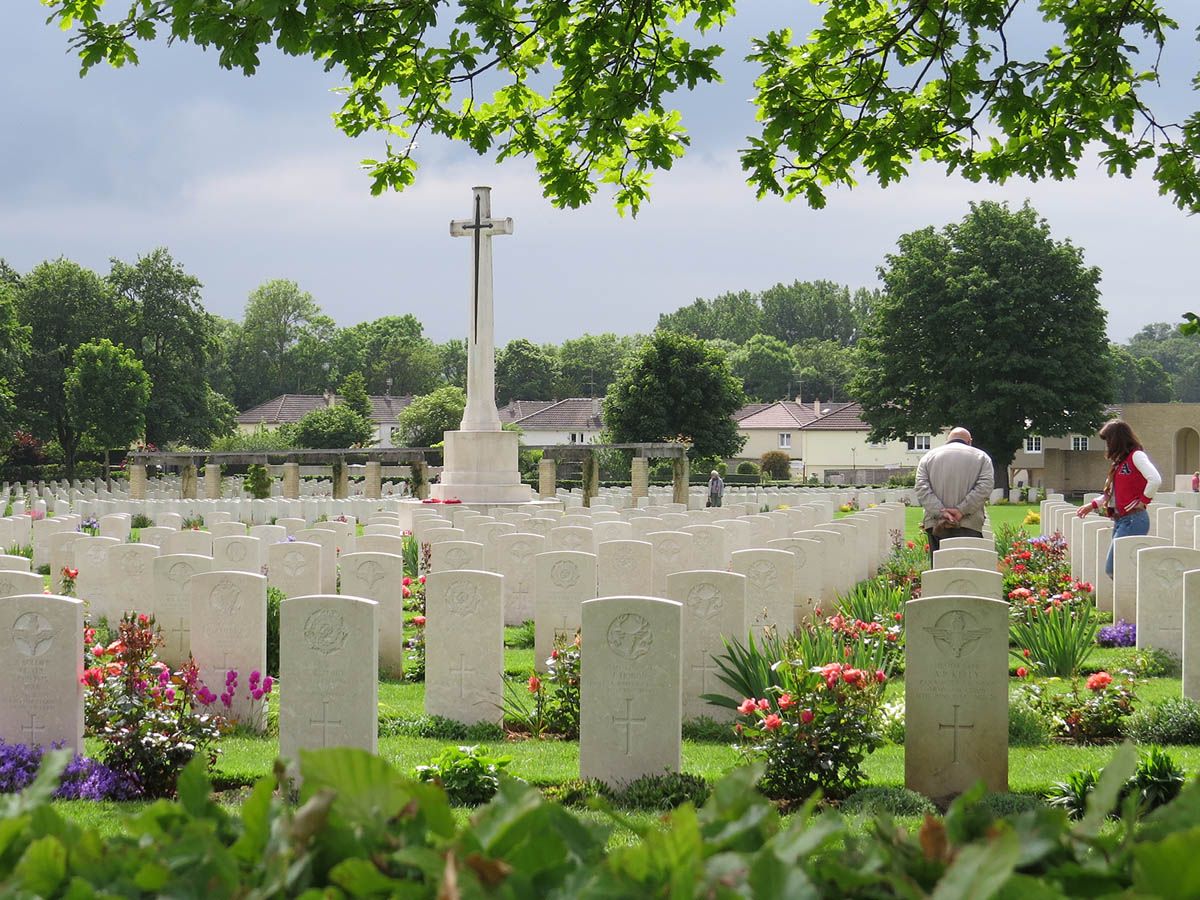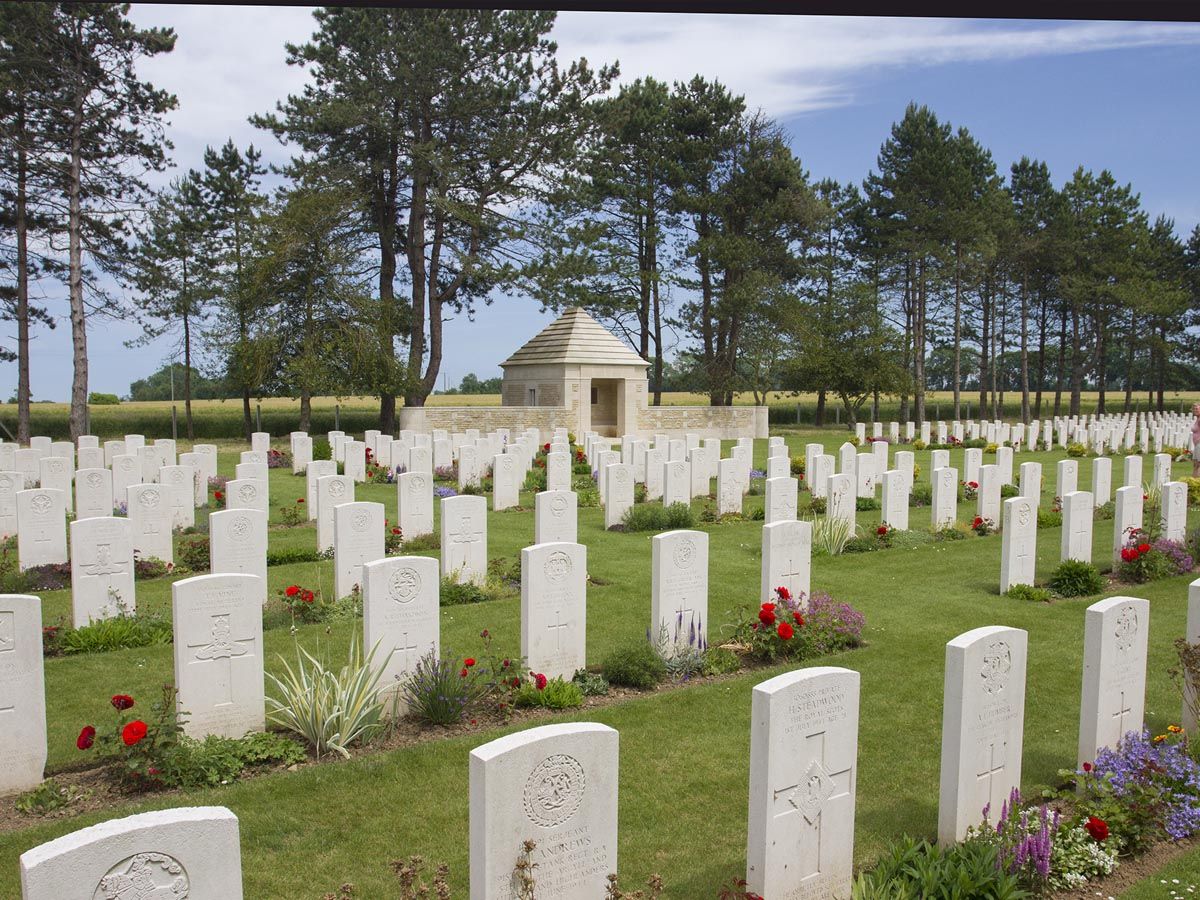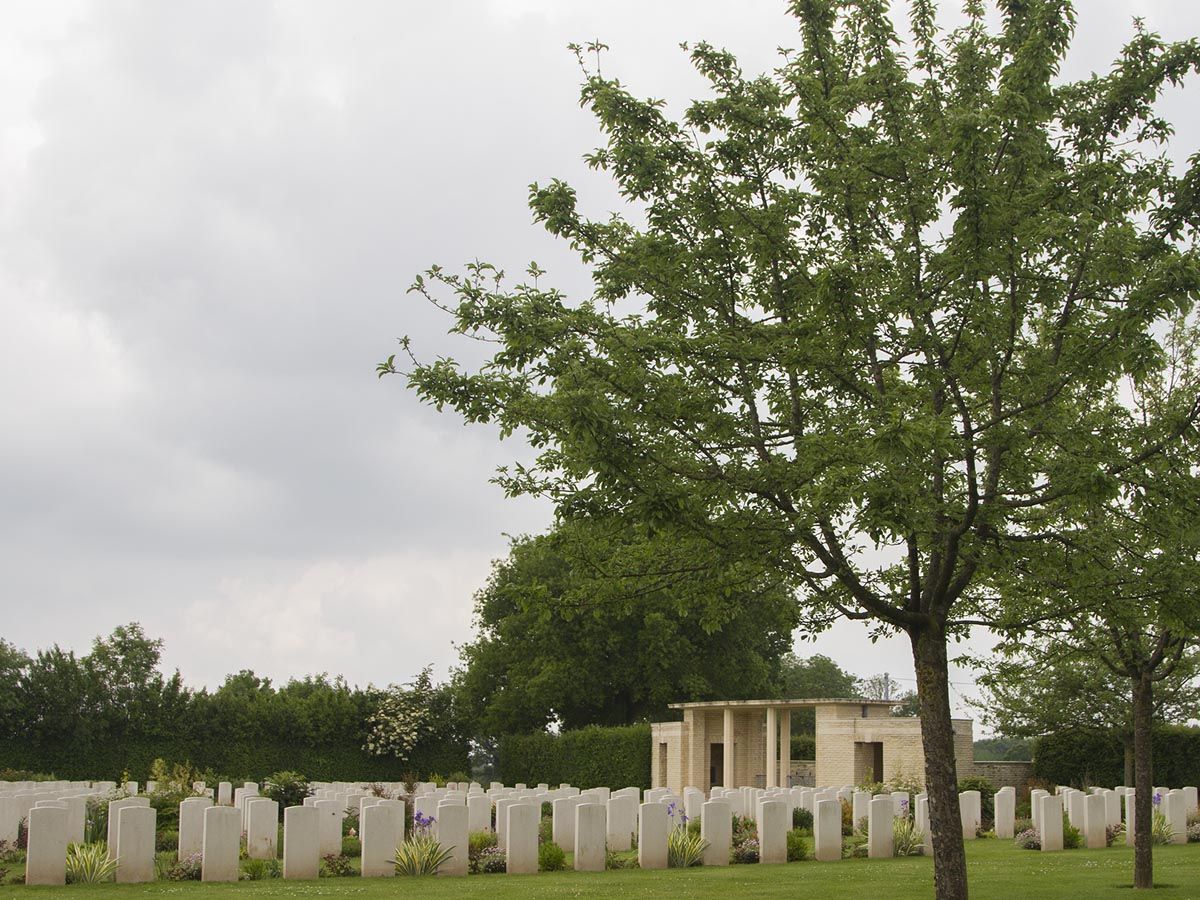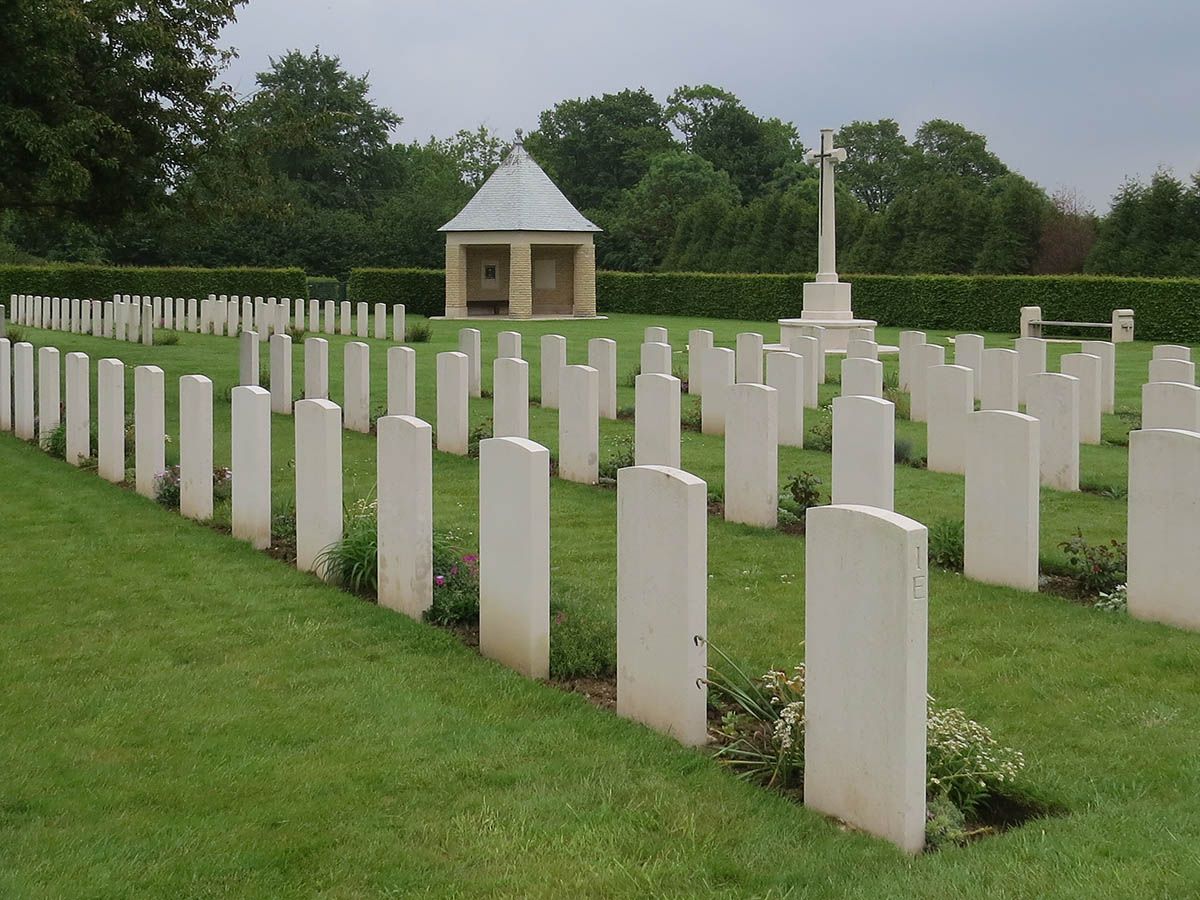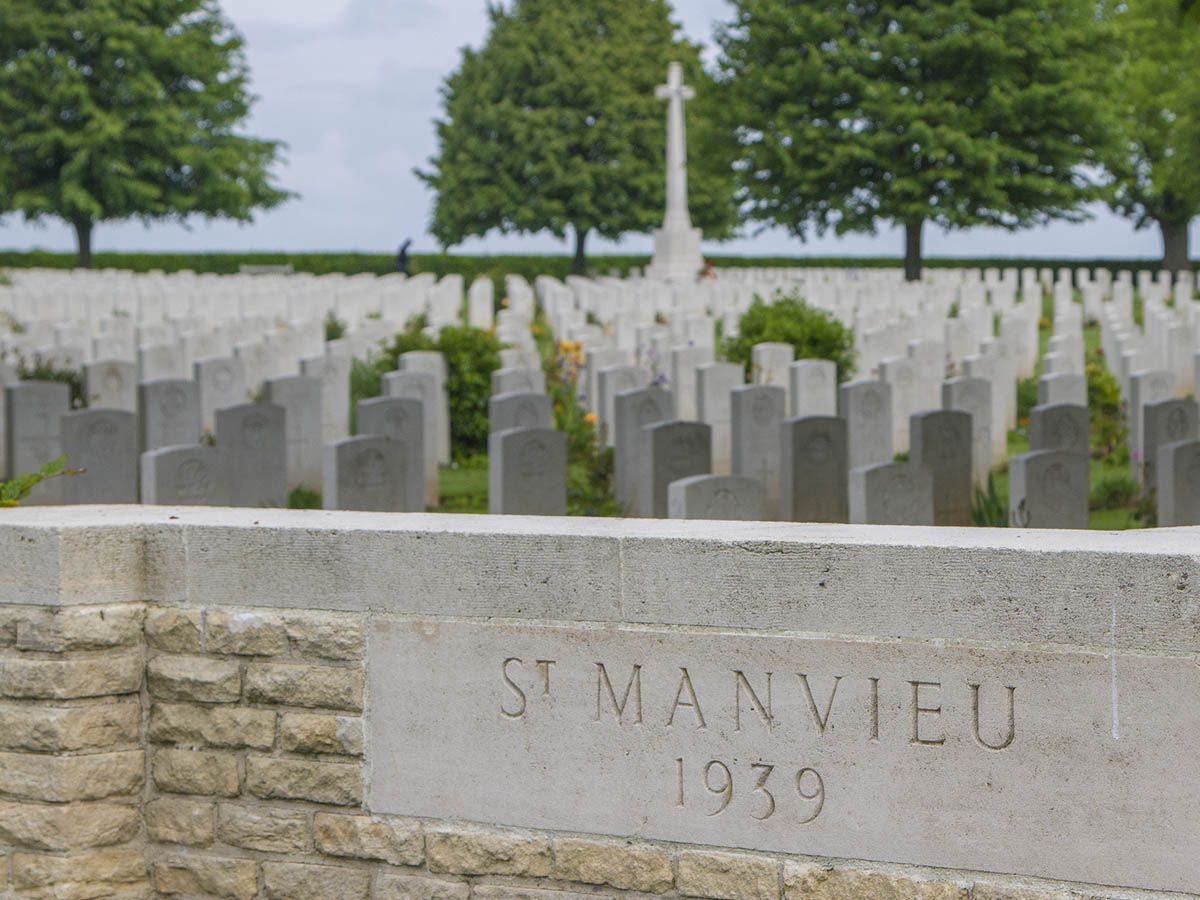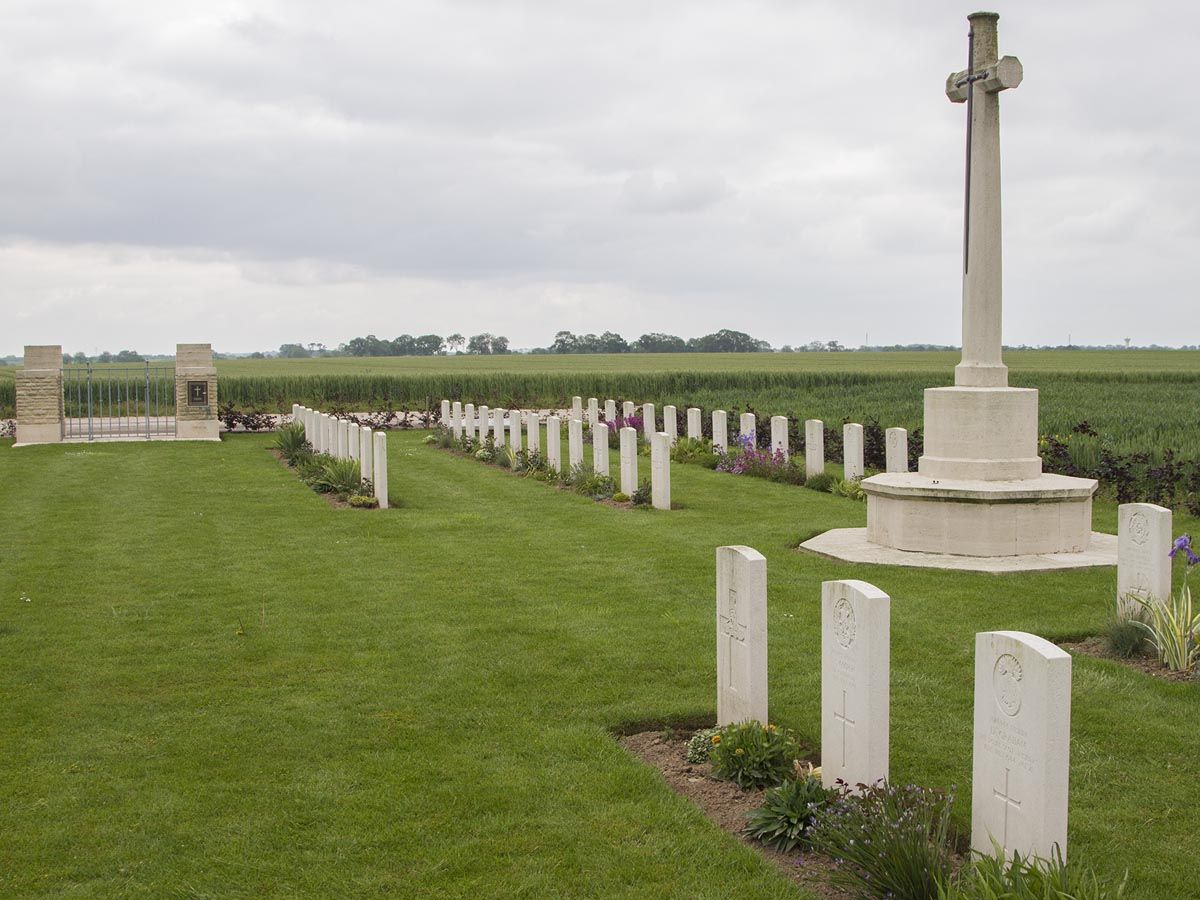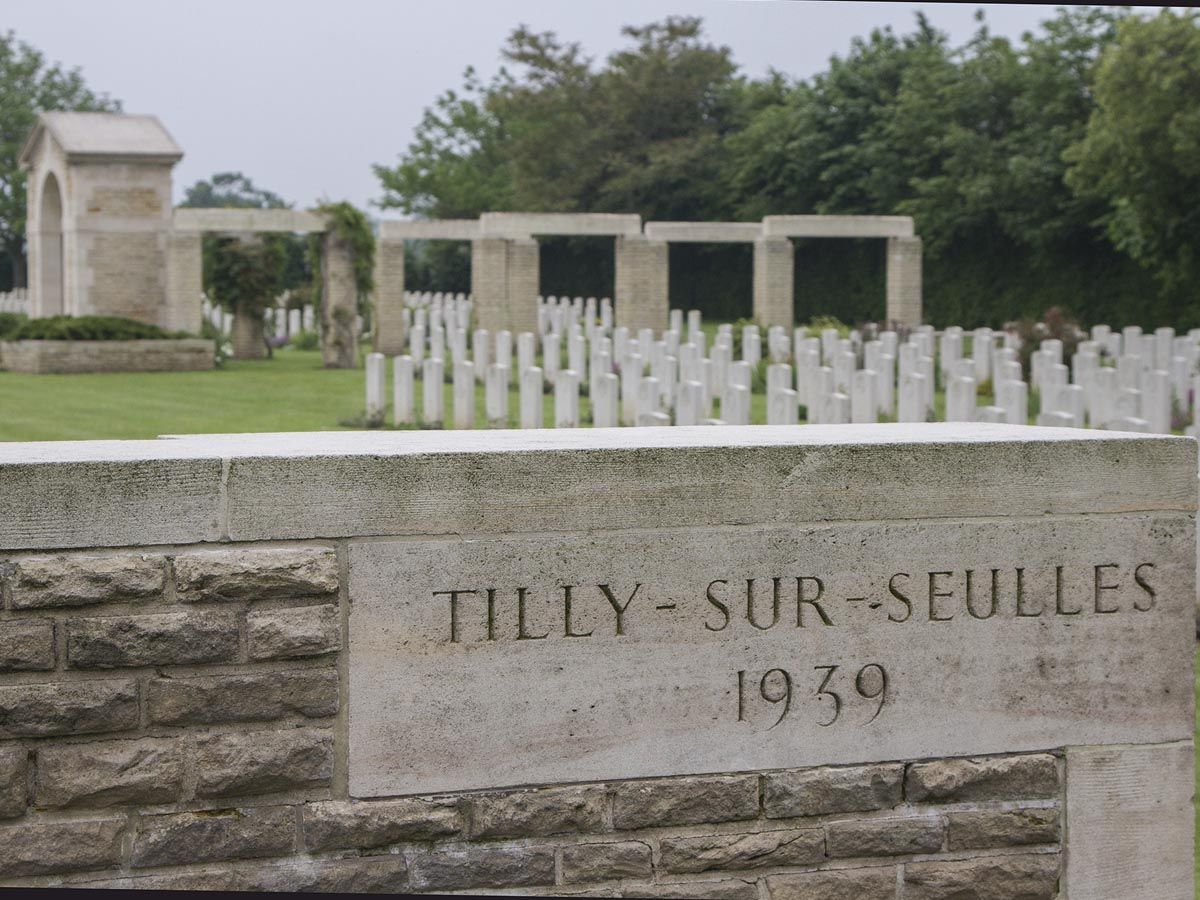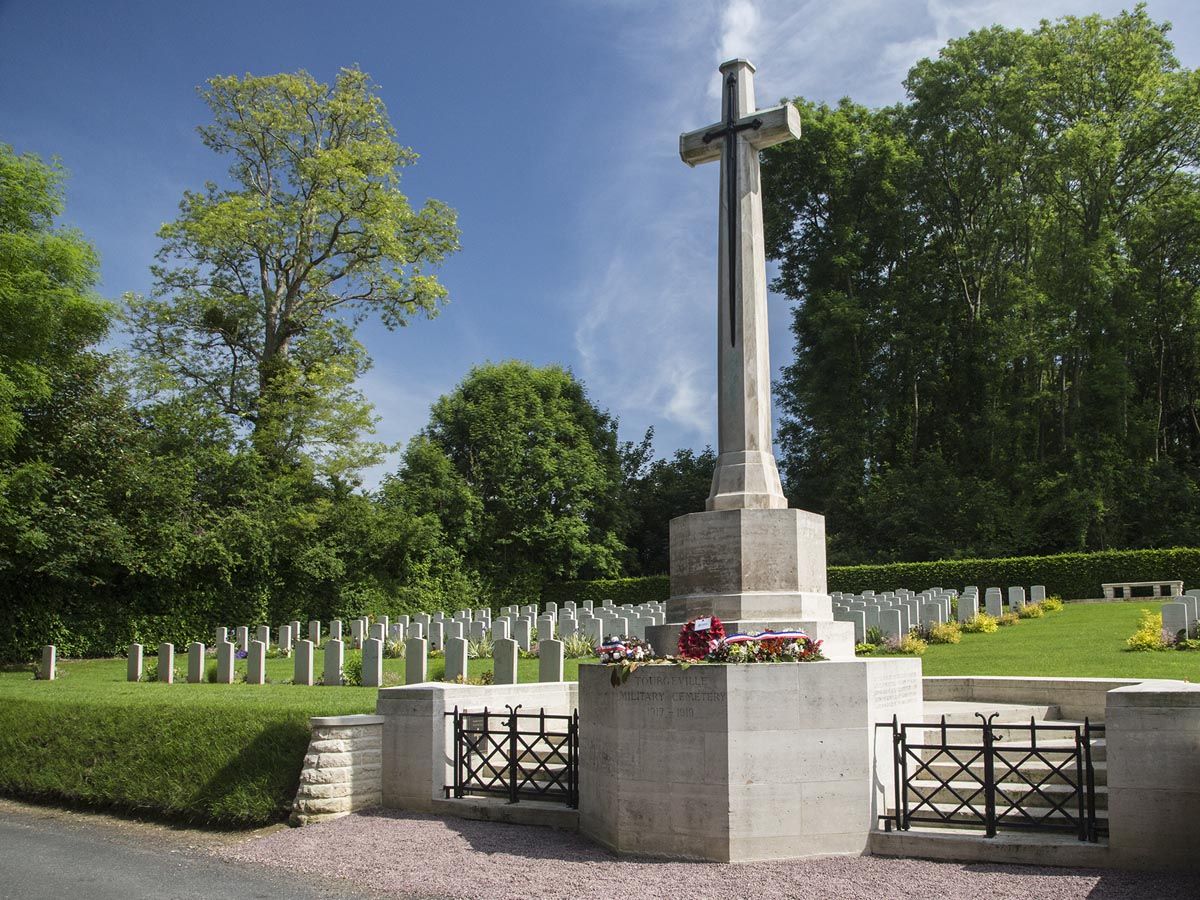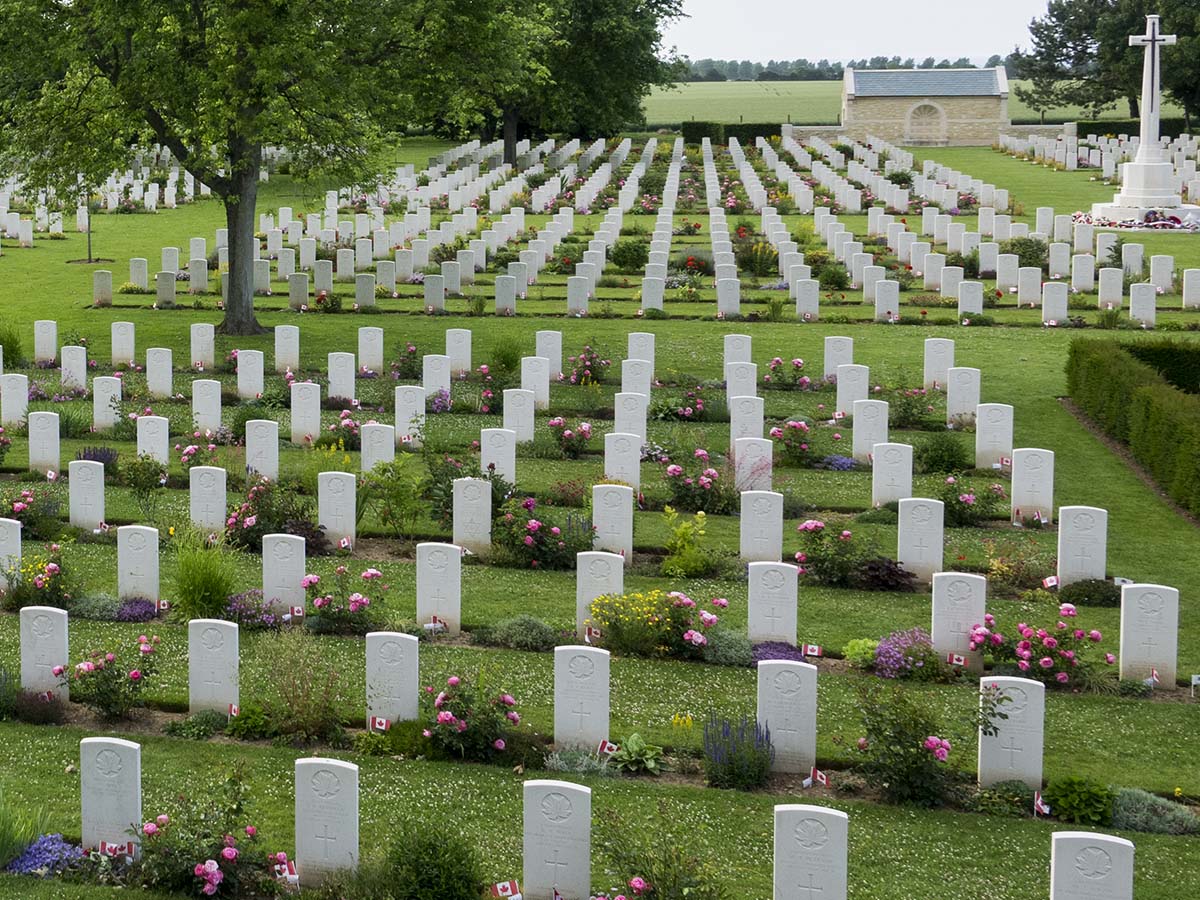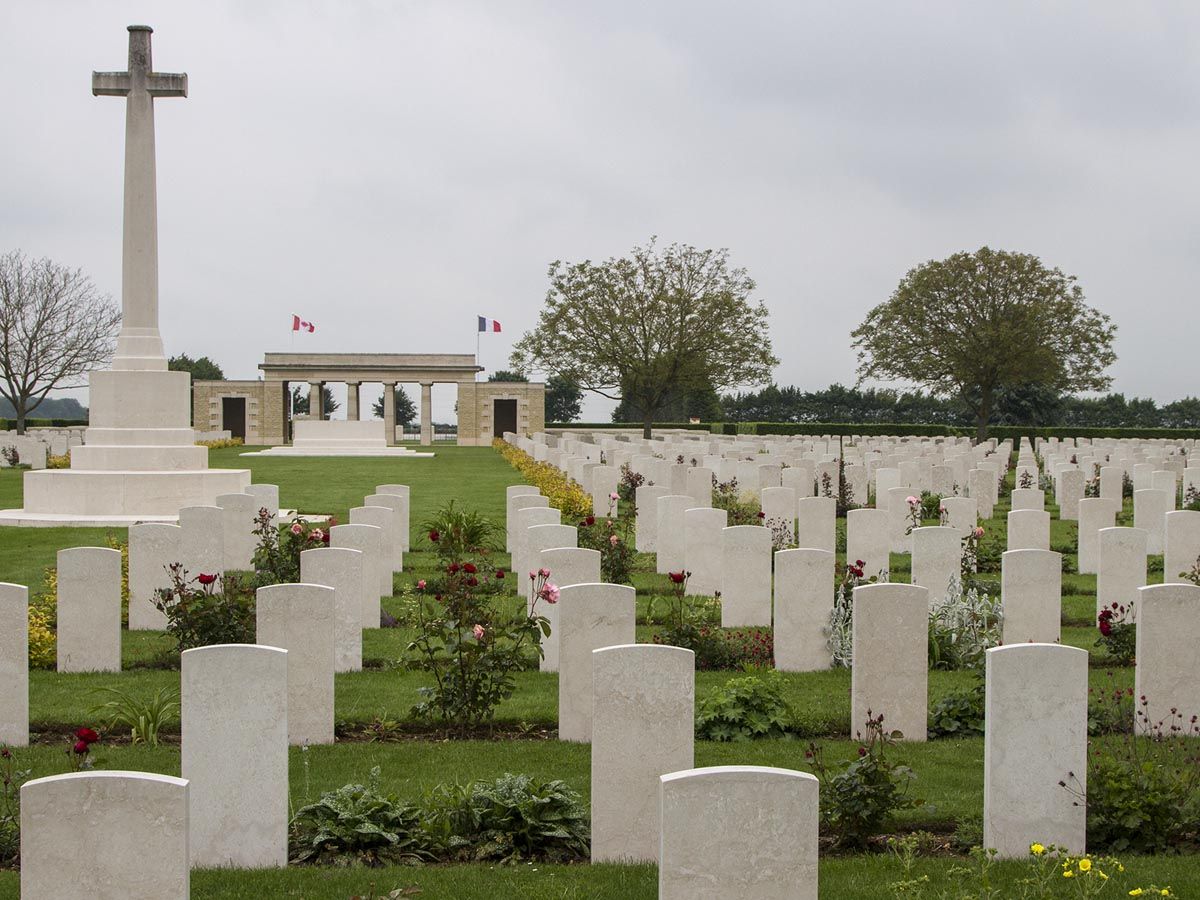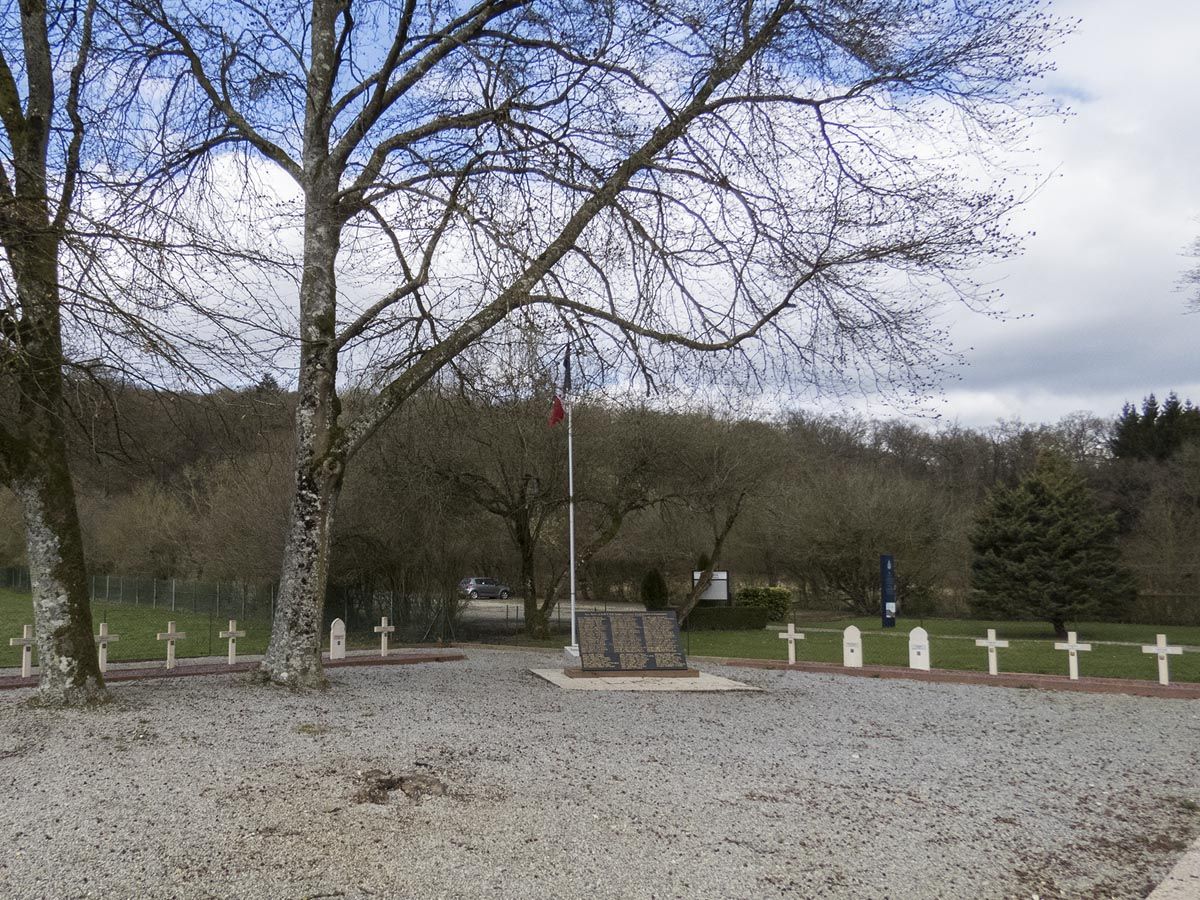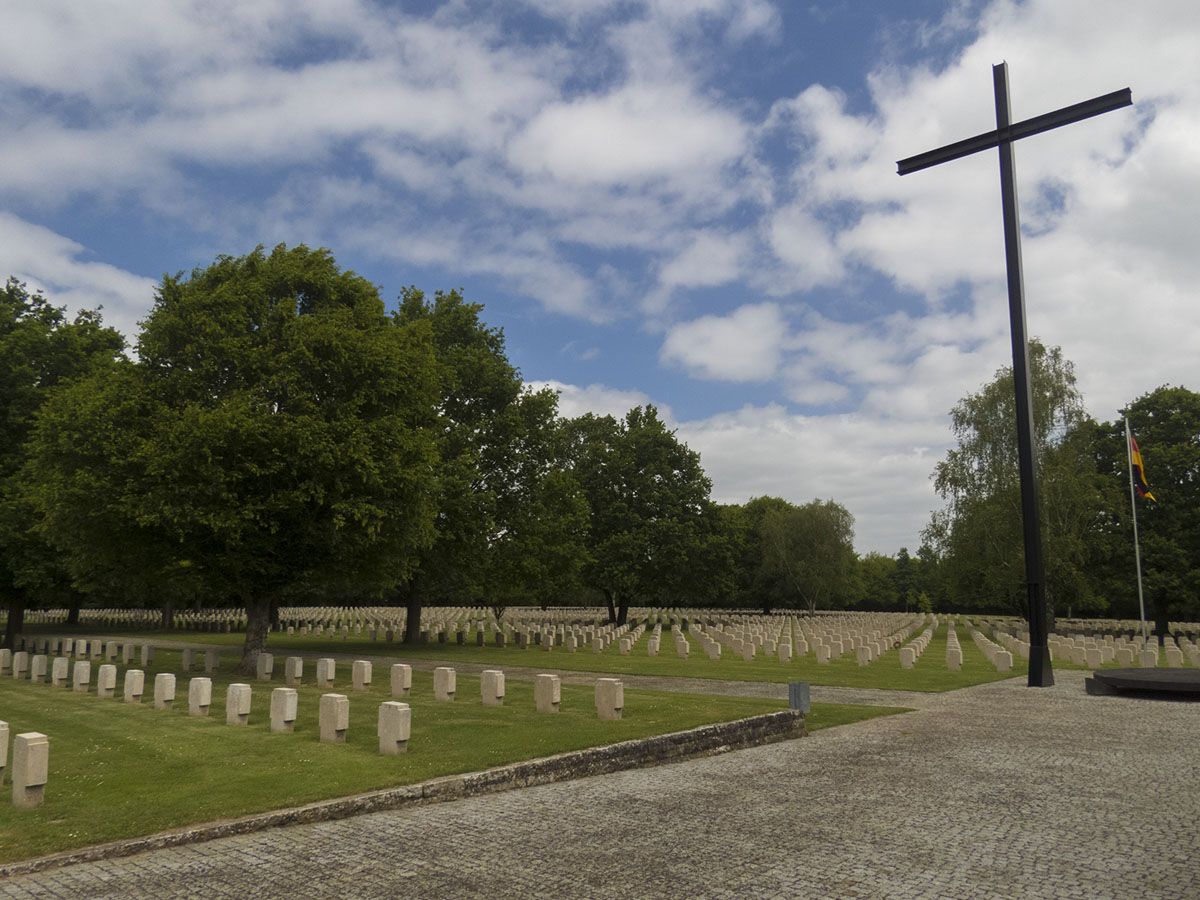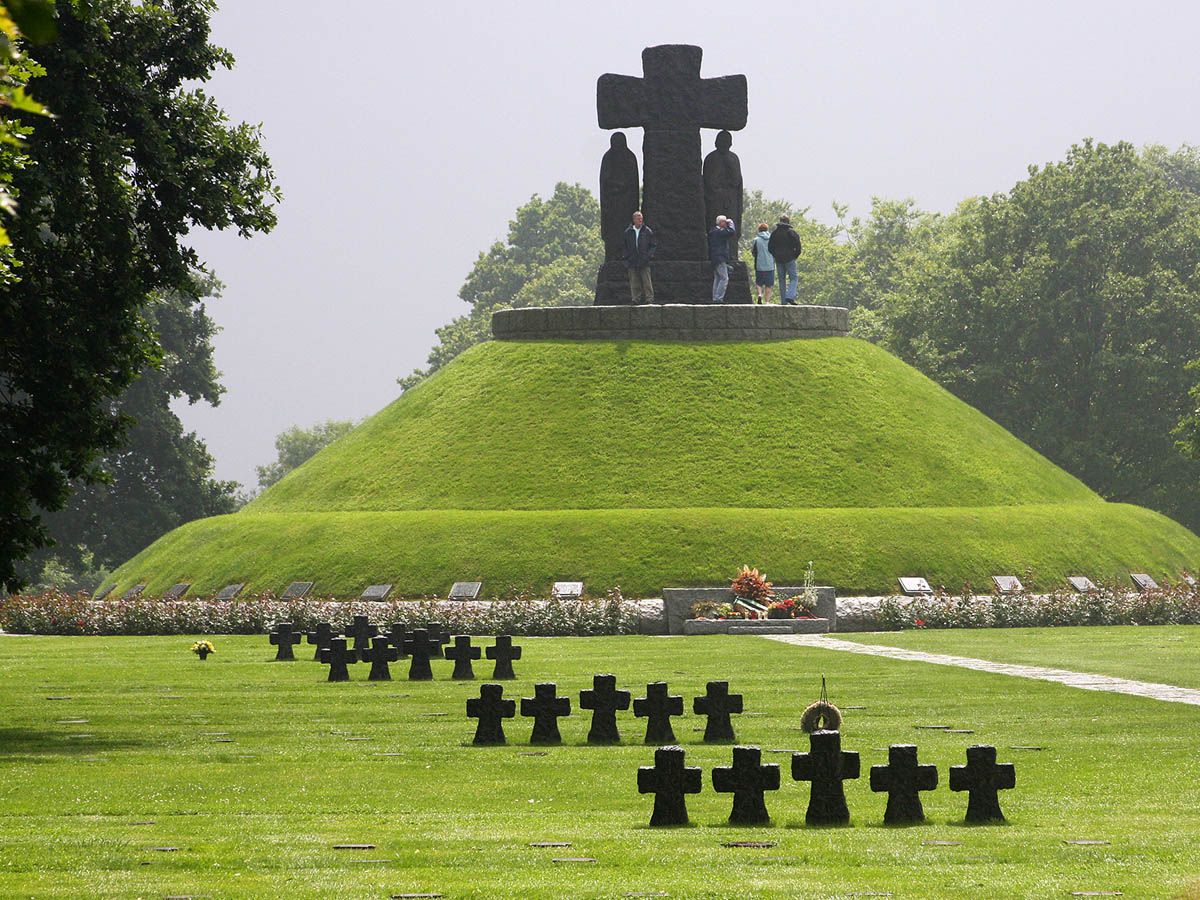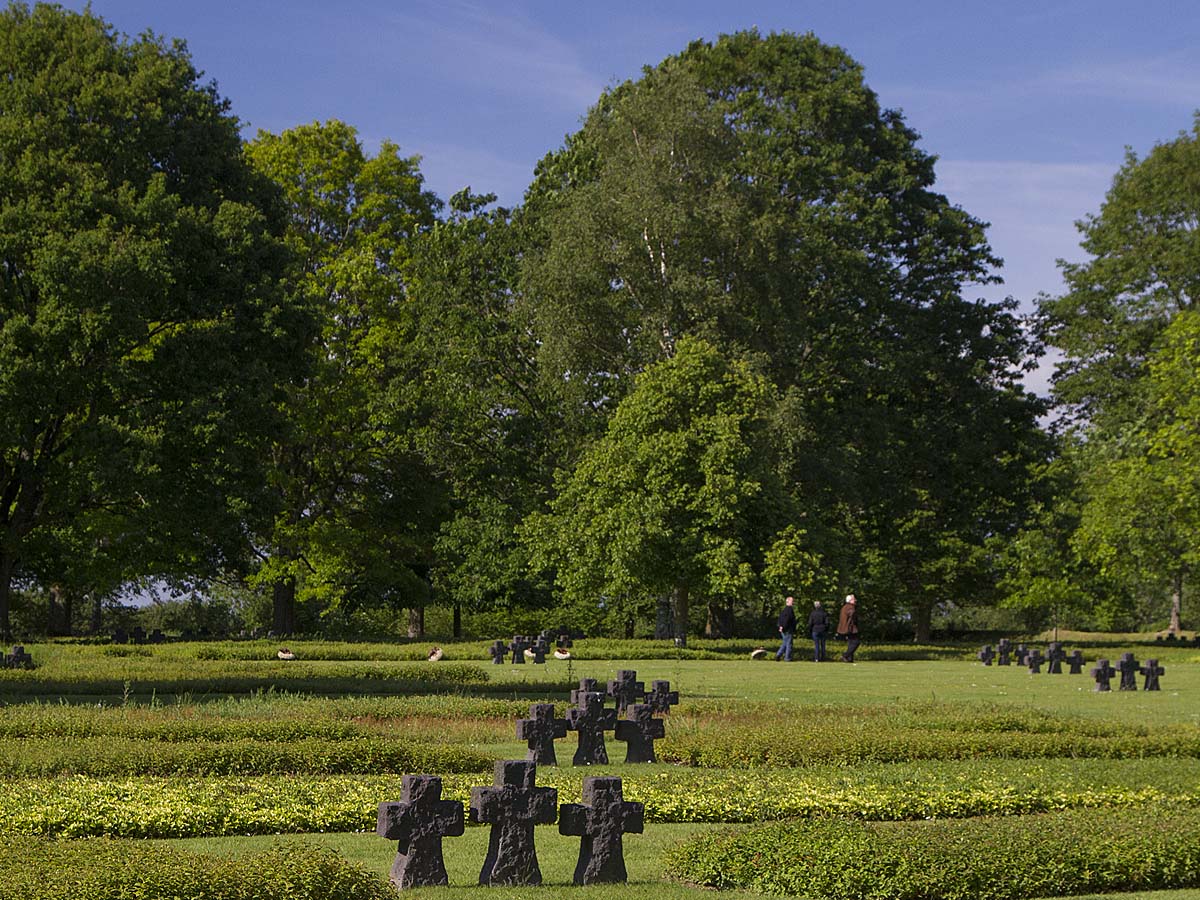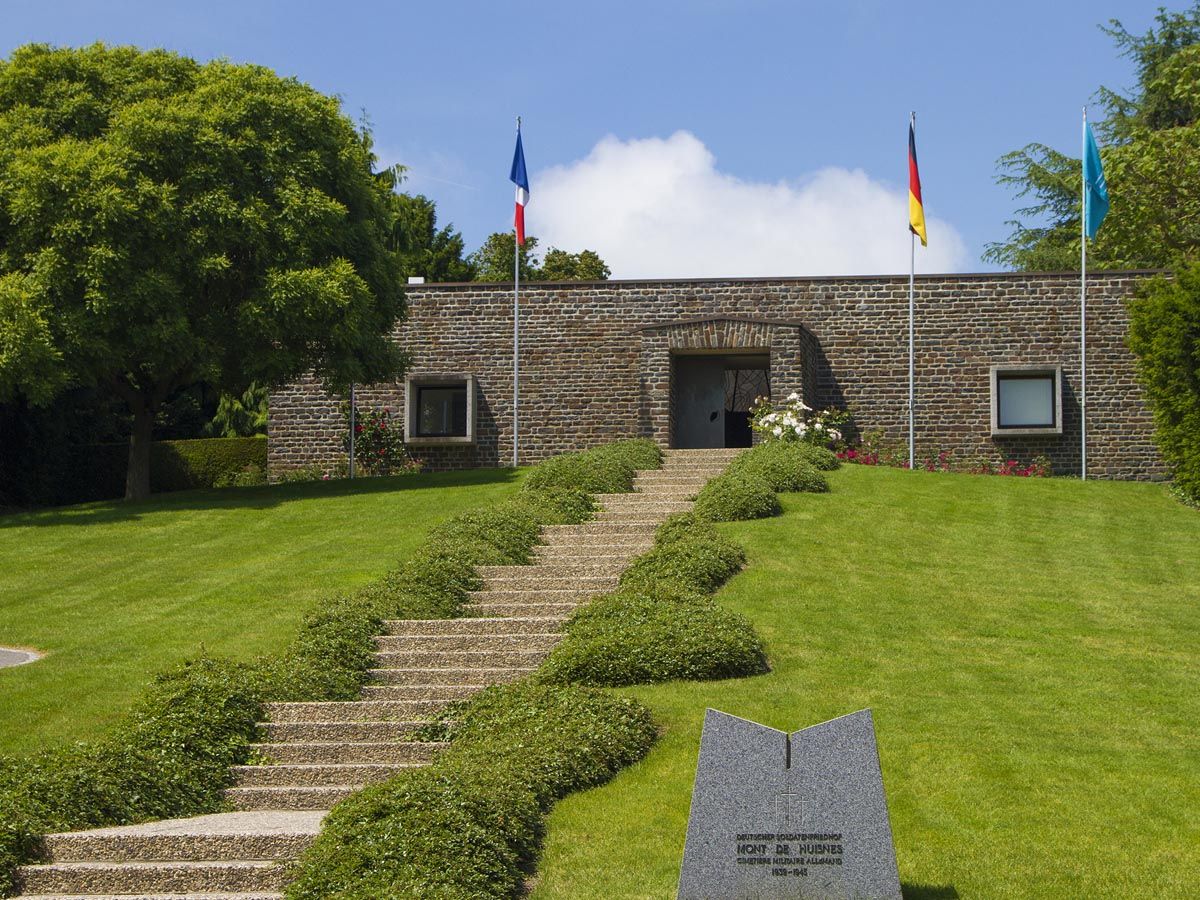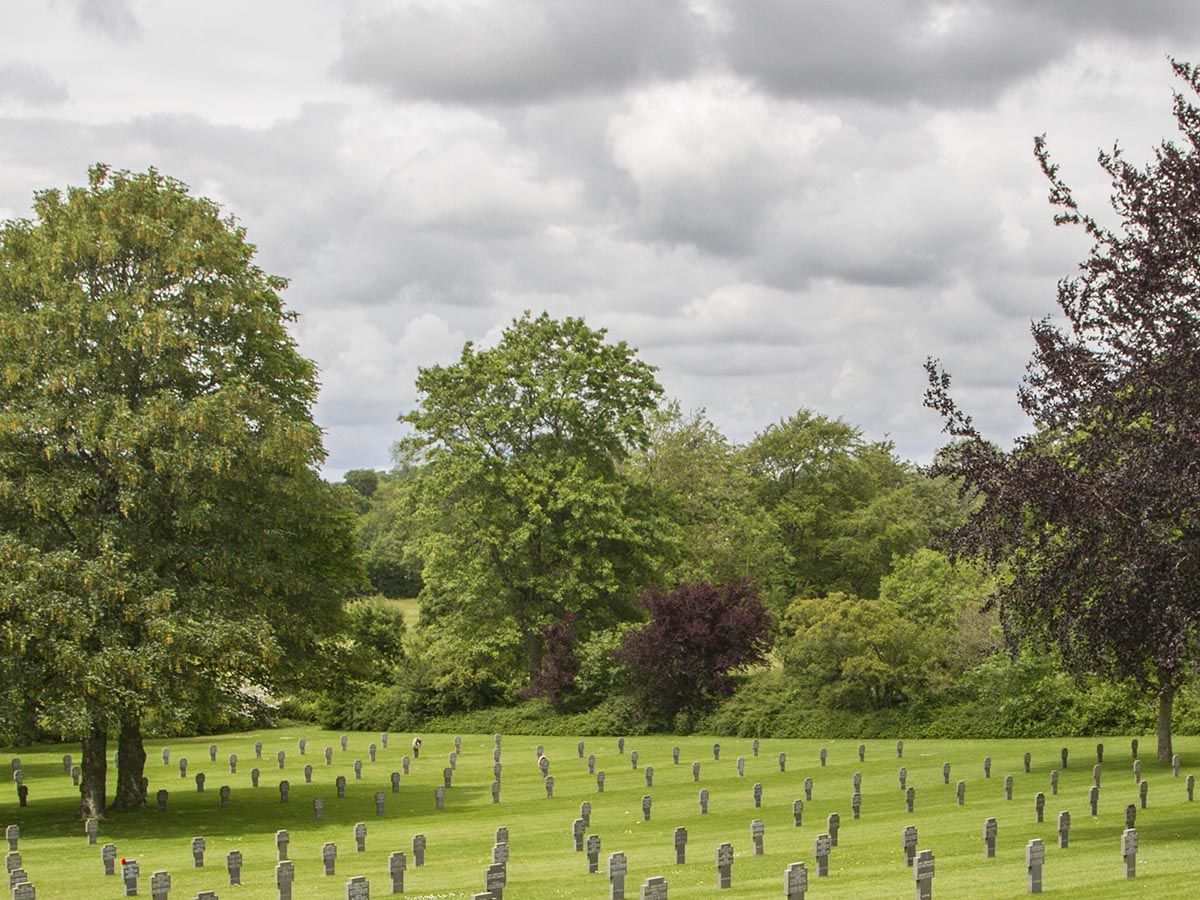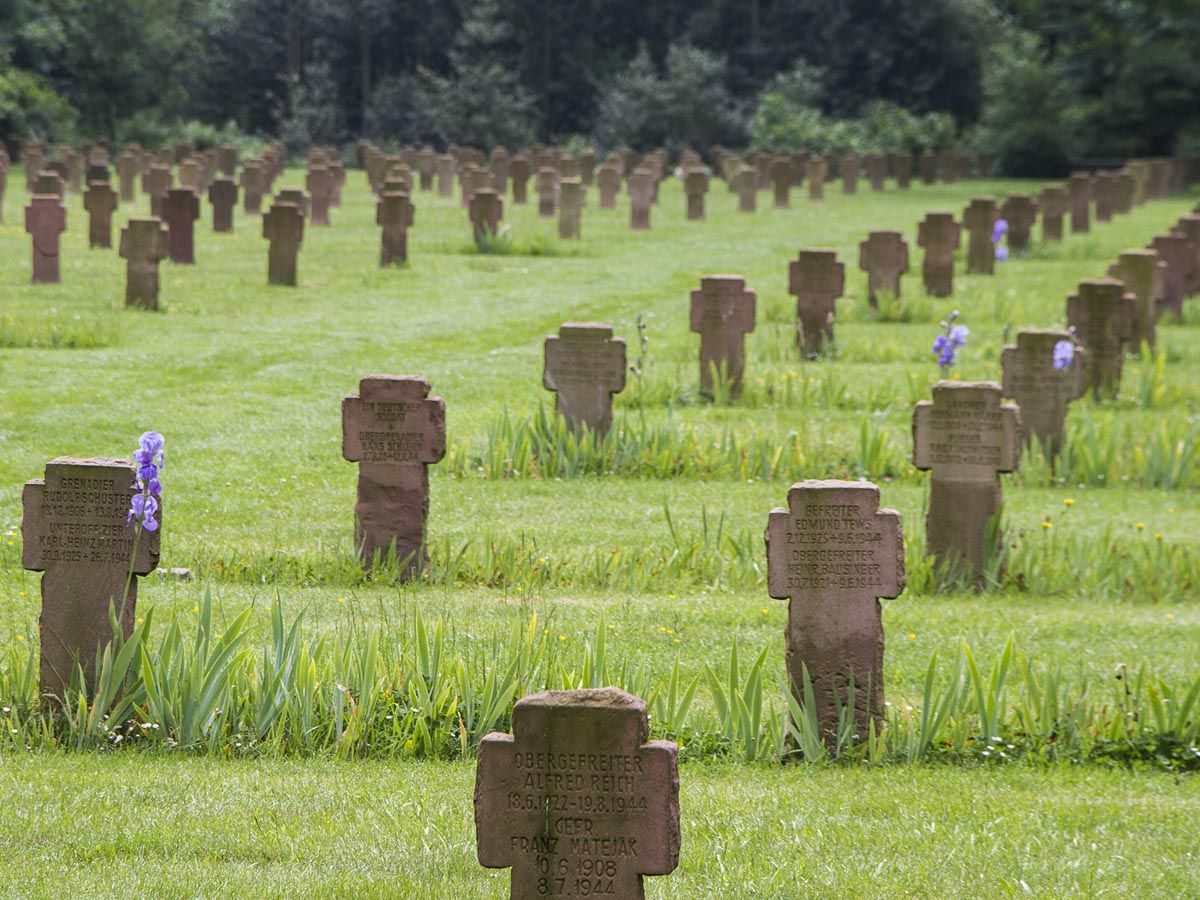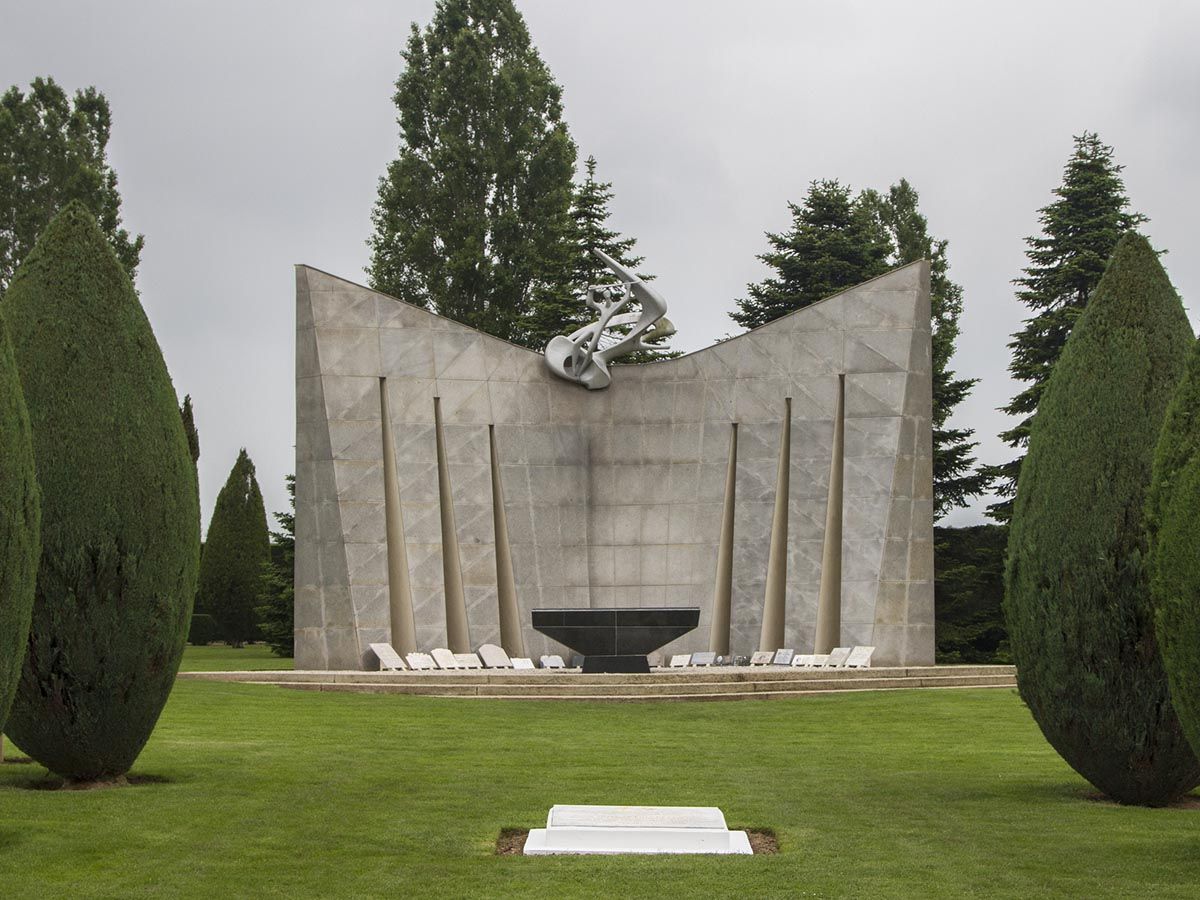Nestled in the quiet village of Bazenville in Normandy, France, the Ryes War Cemetery stands as a solemn reminder of the sacrifices made during the Second World War. This historic site contains 652 Commonwealth burials, one Polish grave, and 335 German burials, making it one of the most significant and diverse final resting places for those who fought in the Normandy campaign. If you’re planning to visit World War II sites in Normandy, Ryes War Cemetery deserves a place on your itinerary as the oldest WW2 cemetery in the region, offering a powerful and moving experience.
While slightly off the beaten path, the cemetery’s peaceful setting creates a perfect space for reflection on the events that unfolded on nearby Gold Beach during the D-Day landings. Many of the British soldiers buried here were among the first waves of troops who came ashore on June 6, 1944, and in the days that followed.
You can now explore this historic site through virtual tours available on a free mobile app, allowing you to connect with these stories even before your visit.
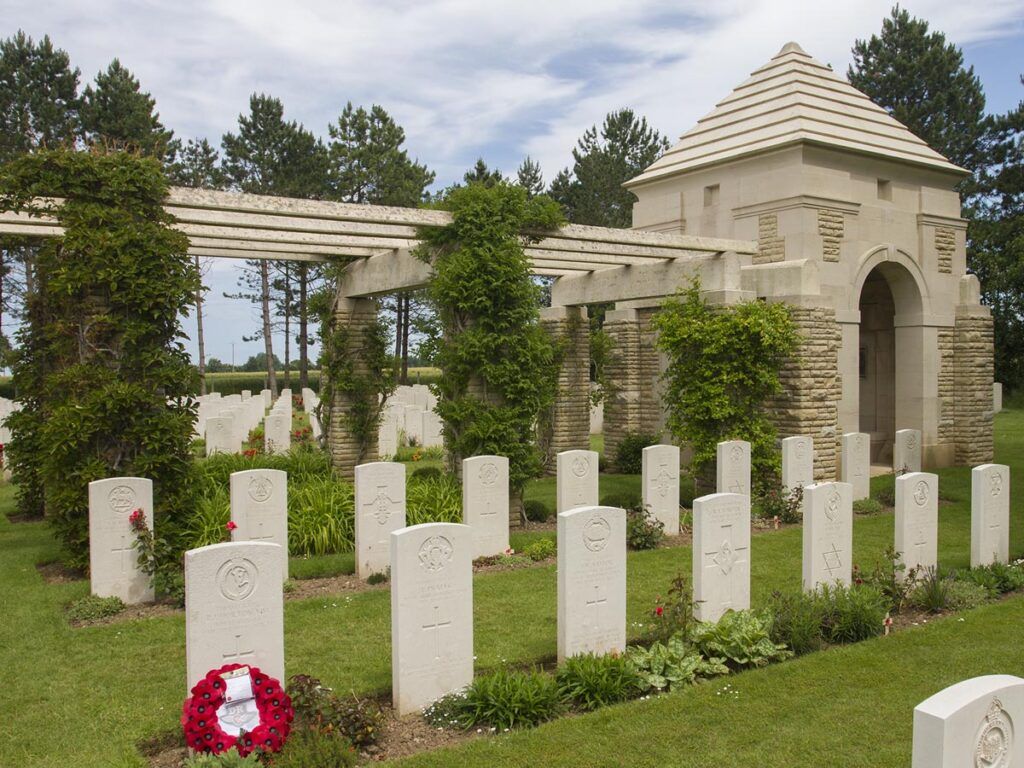
History and Significance
Ryes War Cemetery stands as a solemn tribute to those who fell during the pivotal moments of World War II. This peaceful resting place tells the story of courage and sacrifice that shaped modern Europe.
Ryes War Cemetery Origins
Ryes War Cemetery was established in the days following the Allied invasion of Normandy. Located near the quiet town of Bazenville, about 8 km east of Bayeux, the cemetery was created to honor those who gave their lives during the early stages of the liberation of France.
The cemetery holds 652 Commonwealth burials, alongside 335 German graves and one Polish burial. This mix of nationalities reflects the global nature of the conflict that engulfed Europe.
When you visit, you’ll notice the immaculate maintenance by the Commonwealth War Graves Commission, who have cared for this site since its creation as a permanent memorial after the war.

The Battle of Normandy
Following the D-Day landings on June 6, 1944, Allied forces fought intensely to push inland from the beaches. The Battle of Normandy continued throughout the summer of 1944, with troops facing fierce resistance from German defenders.
Many soldiers buried at Ryes fell during these crucial weeks of combat. As you walk among the graves, you’re witnessing the human cost of one of history’s most significant military campaigns.
The fighting around Bazenville was particularly intense as Allied forces worked to secure the area and establish a foothold for further advances.
This cemetery represents just a fraction of the estimated 209,000 Allied casualties suffered during the Normandy campaign.
D-Day Landings
The D-Day invasion began the liberation of Western Europe with a massive seaborne and airborne assault on June 6, 1944. Code-named Operation Overlord, it remains the largest amphibious military operation in history.
Many of those laid to rest at Ryes fell during the initial landings on nearby beaches like Gold, Juno, and Omaha. As you explore the cemetery, you’ll find the graves of young men who died within hours or days of reaching French soil.
The cemetery’s peaceful setting contrasts sharply with the violence of those June days. Standing here, you can reflect on how these soldiers—many just 18 or 19 years old—helped change the course of history.
Their sacrifice paved the way for the eventual Allied victory less than a year later.
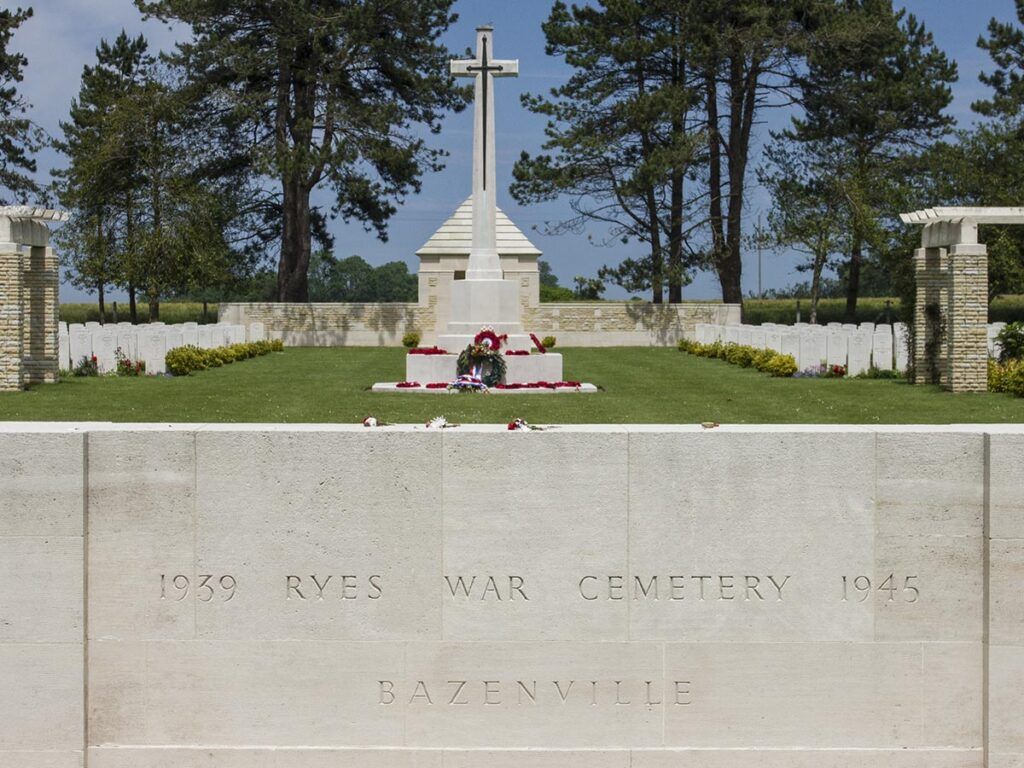
The Cemetery Grounds
Ryes War Cemetery offers visitors a solemn yet beautifully maintained space for reflection. The carefully designed grounds hold both Commonwealth and German graves, creating a peaceful resting place for those who fell during the Normandy campaign.
Layout and Graves
The cemetery contains 652 Commonwealth burials, one Polish grave, and 335 German graves. When you enter, you’ll notice the immaculate layout with straight rows of headstones set against manicured lawns.
Most of the Commonwealth soldiers buried here are British troops who landed on Gold Beach during the D-Day operations. Their white Portland stone headstones create a striking visual contrast with the green grass.
The German graves are marked with darker stones, set in a different section of the cemetery. This respectful separation acknowledges both sides of the conflict while honoring all who lost their lives.
The cemetery is one of the oldest WW2 burial grounds in Normandy, established shortly after the landings began.
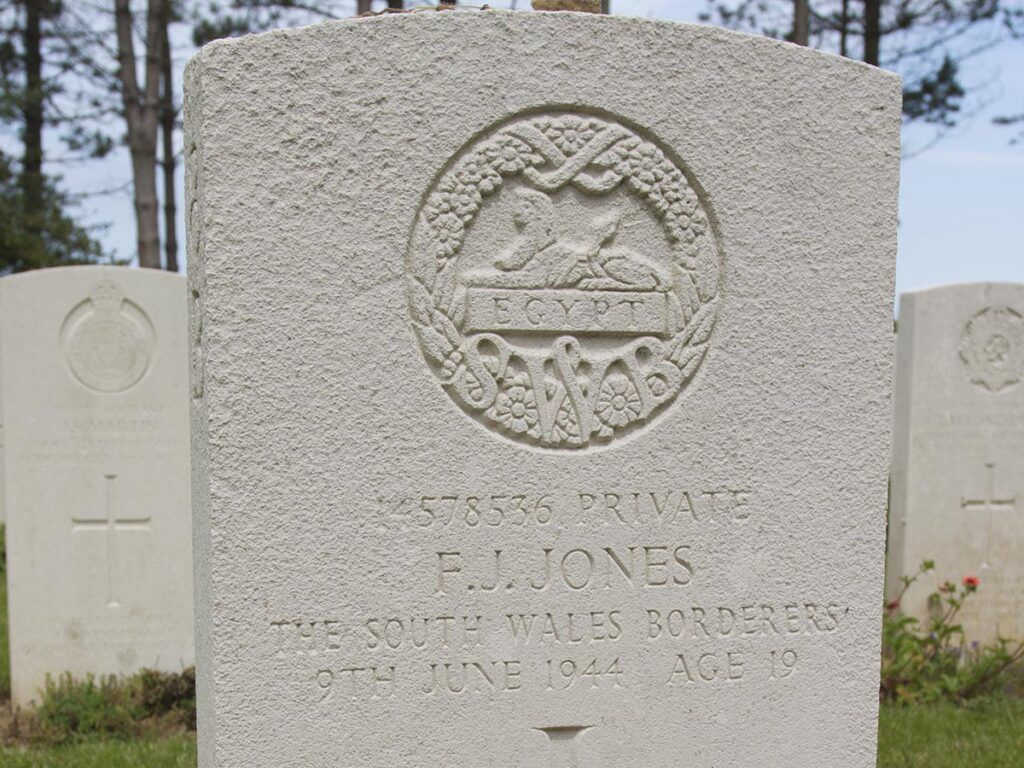
The Central Memorial
At the heart of Ryes War Cemetery stands the Stone of Remembrance. This simple yet powerful monument bears the inscription “Their Name Liveth For Evermore,” chosen by Rudyard Kipling for Commonwealth war cemeteries.
Near the central memorial, you’ll find the registry building. Inside, a visitors’ book allows you to leave your thoughts and reflections.
The cemetery’s design follows the Commonwealth War Graves Commission’s principles of uniformity and equality in death. No matter rank or position, each soldier receives equal commemoration.
Recently, the cemetery added digital memory tours available through a free mobile app. These tours provide context and stories about those buried here.
Notable Burials
Many Royal Artillery soldiers rest in Ryes Cemetery, having supported the infantry landings with crucial artillery fire. Their headstones often display the Royal Artillery insignia.
You’ll find numerous soldiers from the 50th (Northumbrian) Infantry Division, which was responsible for securing Gold Beach during the initial landings.
Several tank crew members from the 8th Armoured Brigade lie here, having fallen while providing armored support to infantry units pushing inland.
Some graves belong to airmen from the Royal Air Force who supported the ground operations with aerial reconnaissance and bombing missions.
Look for the dates on headstones – many show June 6-12, 1944, revealing the cemetery’s connection to the earliest and often most brutal fighting of the Normandy campaign.
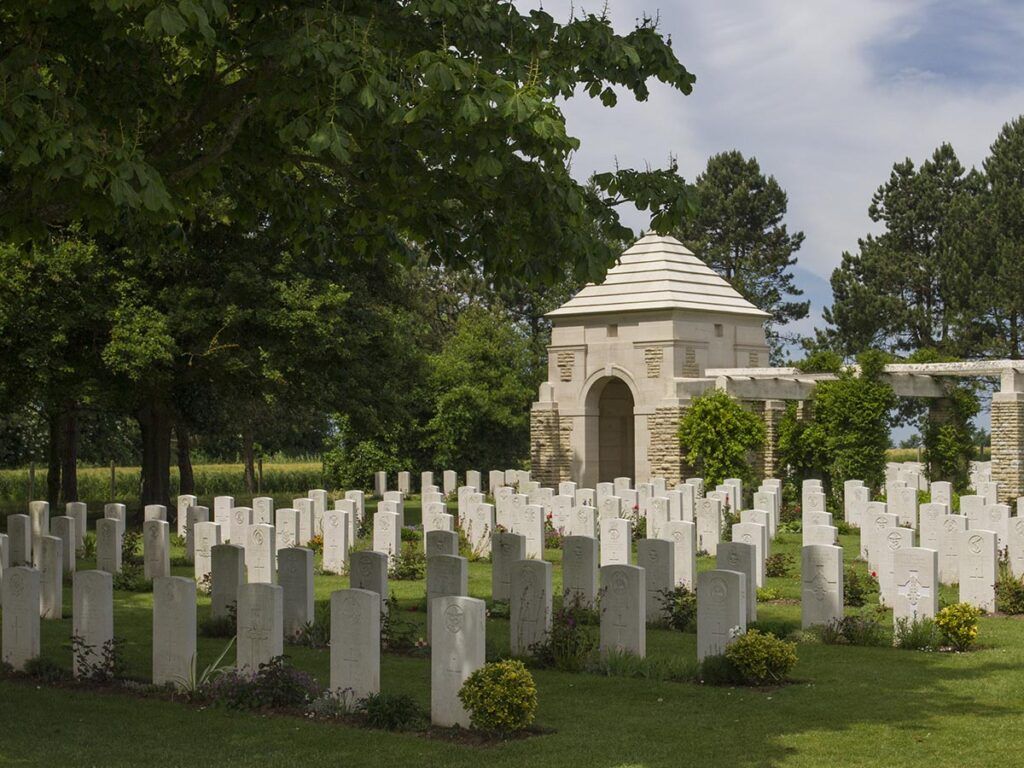
Visiting Ryes War Cemetery
Ryes War Cemetery in Bazenville, Normandy offers a moving tribute to the fallen soldiers of World War II. This Commonwealth cemetery provides a peaceful place for reflection and remembrance while learning about the sacrifices made during the Normandy landings.
Getting to Ryes War Cemetery
Ryes War Cemetery is located in the small village of Bazenville, about 12 kilometers northeast of Bayeux. If you’re driving, take the D12 road from Bayeux toward Arromanches and follow signs to Bazenville. The cemetery is just outside the village.
Public transportation options are limited, so renting a car gives you the most flexibility. Alternatively, you can take a taxi from Bayeux, which will cost around €25-30 one way.
Many visitors combine their trip with other D-Day sites in the area. The cemetery is just 4 kilometers south of Gold Beach, one of the main landing beaches during the Allied invasion of Normandy.
Best Times to Visit
The cemetery is open year-round and accessible to visitors at no cost. Morning visits (9:00-11:00 AM) often provide the most peaceful experience with fewer tour groups.
Spring and fall offer the most pleasant weather conditions, with temperatures typically ranging from 15-22°C (60-72°F). The grounds are particularly beautiful in late spring when flowers bloom around the graves.
June 6th and surrounding days mark the D-Day anniversary, bringing special commemorations but also larger crowds. If you visit during this time, arrive early.
Winter visits can be poignant, with fewer visitors allowing for quiet reflection, though be prepared for potential rain and chilly conditions between November and March.
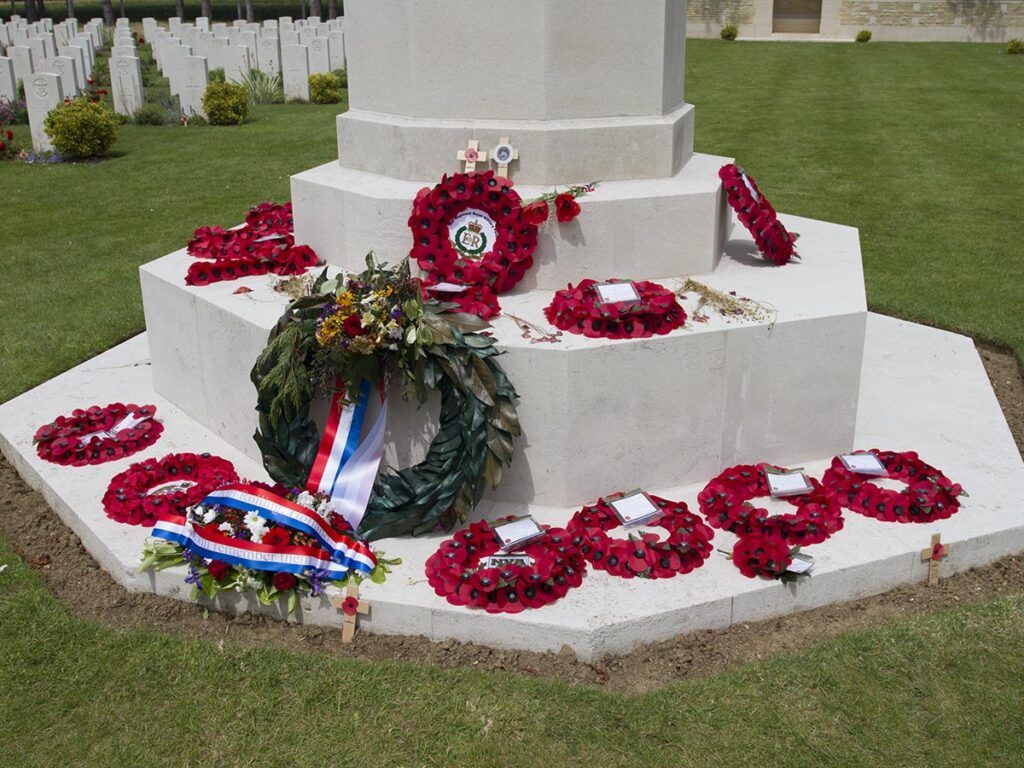
Nearby Accommodations
We recommend staying in Bayeux, as it’s the best central location for all WW2 locations.
Recommended hotels:
Booking 3-6 months in advance is recommended, especially if you’re visiting during summer or around D-Day anniversaries.
Tours
The Commonwealth War Graves Commission offers a free Memory Anchor tour through their mobile app. Download it before your visit for an enhanced experience with historical context about the cemetery and those buried there.
Recommended D-Day Tours from Paris:
- From Paris: Normandy D-Day Beaches Day Trip
- From Paris: 2-Day Normandy & Brittany Tour
- Normandy American D-Day Experience (From Bayeux Station)
Recommended D-Day Tours from Bayeux:
- From Bayeux: American D-Day Sites in Normandy Full-Day Tour
- From Bayeux: American D-Day Sites in Normandy Half-Day Tour
- From Bayeux: Half-Day Normandy WWII Sidecar Tour
- Full-Day US Battlefields of Normandy Tour from Bayeux
Recommended Private D-Day Tours:
- From Paris: Normandy D-Day Landing Beaches Full-Day Tour
- From Rouen: Normandy D-Day Beaches Private Full-Day Tour
- Private Tour: Rouen, Bayeux, and Falaise Day Trip from Bayeux
- Normandy WWII Private Half-day Sidecar Tour From Bayeux
Recommended Band of Brothers Tours:
A guided tour helps you understand the cemetery’s significance in the broader context of Operation Overlord. Most tours last 4-6 hours and cost between €70-120 per person, including transportation from Bayeux.
Self-guided visits are also rewarding. The cemetery’s visitors’ book and informational panels provide details about the 652 Commonwealth servicemen buried here.
Ceremonies and Events
Ryes War Cemetery hosts several meaningful ceremonies throughout the year that honor the 652 Commonwealth, 1 Polish, and 35 German soldiers buried there. These events provide visitors with powerful ways to connect with history and pay respects.
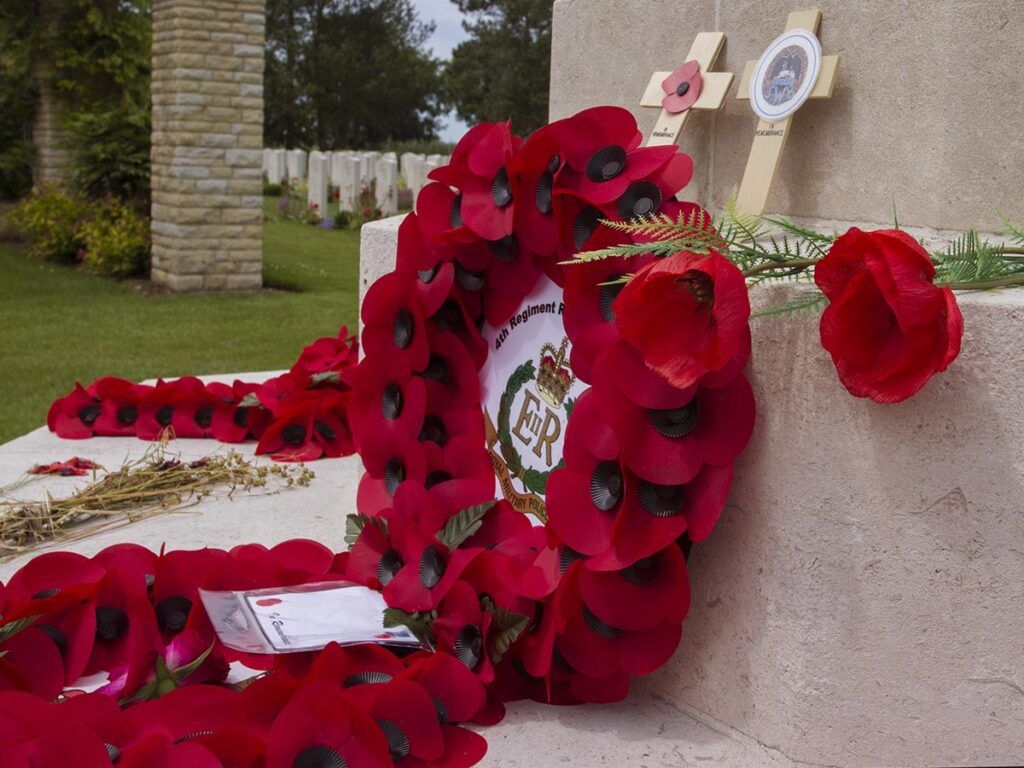
Annual Commemorations
D-Day anniversary ceremonies take place each year on June 6th at Ryes War Cemetery. You’ll find veterans, military representatives, and local officials gathering to honor those who made the ultimate sacrifice during the Normandy landings. The ceremony typically includes wreath-laying, readings, and moments of silence.
Remembrance Day (November 11th) also brings special commemorations to the cemetery. Local schoolchildren often participate, placing flowers or small flags at graves.
If you plan to attend these ceremonies, arrive early as they can draw large crowds, especially during significant anniversaries. Bringing flowers is appropriate if you wish to place them at graves afterward.
Special Tours
The Commonwealth War Graves Commission offers guided Memory Anchor tours through their free mobile app. These digital guides help you explore the cemetery while learning about specific individuals buried there and their D-Day stories.
During summer months (June-August), you might find volunteer historians conducting walking tours. These experts provide context about the cemetery’s creation following the D-Day landings and share stories of notable burials.
Special candlelight tours occasionally take place on significant anniversaries. These evening events create a particularly moving atmosphere as you walk among illuminated headstones.
Check the CWGC website before your visit for updated tour schedules. Comfortable walking shoes are recommended as tours typically last 1-2 hours.
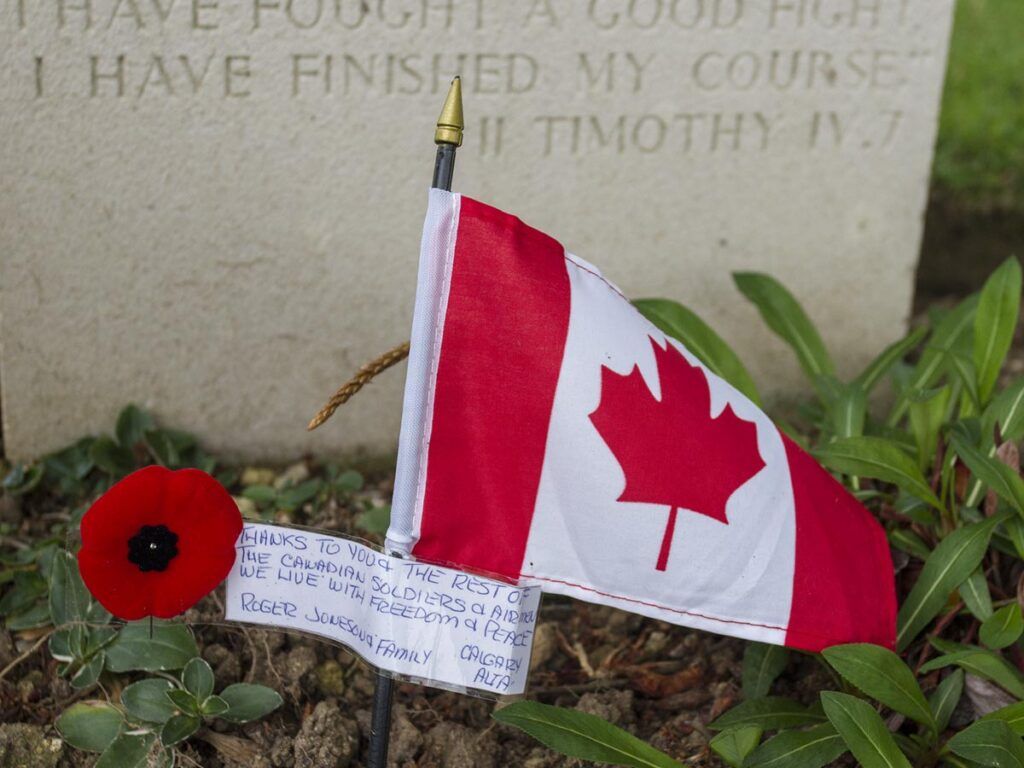
Why It’s Worth Visiting
Ryes War Cemetery offers a deeply moving experience that connects you to the sacrifices made during World War II’s D-Day operations. As the oldest WW2 cemetery in the area, it holds special historical significance.
The cemetery contains nearly 1,000 graves, with the majority being British soldiers who gave their lives during the Normandy campaign. These first burials came in the days immediately following D-Day.
Unlike some of the larger, more frequently visited war memorials, Ryes Cemetery provides a quieter, more reflective atmosphere. Being slightly off the beaten path near Gold Beach gives you space to contemplate and honor the fallen without crowds.
The beautifully maintained grounds showcase the Commonwealth War Graves Commission’s careful stewardship. The orderly rows of headstones create a powerful visual reminder of war’s human cost.
Key reasons to visit:
- Historical significance as the oldest WW2 cemetery in the region
- Close proximity to Gold Beach landing sites
- Opportunity for a more intimate experience than at larger memorial sites
- Beautiful, well-maintained grounds
While exploring, you can take advantage of informative tours that cover different aspects of the site and the Commonwealth service members commemorated here.
The location in the village of Bazenville puts you just a short distance inland from the D-Day beaches, making it an accessible stop on your Normandy battlefield tour.

